WHO is the KING of GLORY
By Alvin Boyd Kuhn
The bible verse referring to "Christ" and the "hope of glory" is Colossians 1:27, which reads, "To them God has chosen to make known among the Gentiles the glorious riches of this mystery, which is Christ in you, the hope of glory". This verse explains that the mystery of the gospel is Christ's indwelling presence within YOU, which brings them the confident hope of sharing in future glory and resurrection WHERE is it? WITHIN YOU.
If the Christ was in most real truth crucified in space, the physical timber on Golgotha’s ghastly height, hewn and sawed and nailed, might be accepted with enlightenment as pure symbol of cosmic and inner process. But as it stands in common thought among Christian people it is the gruesome sign of the most abject stultification of the godlike principle of intelligence known to history.
Lundy says that Plato must have learned his theology in Egypt and the East, and doubtless knew, from the stories of Krishna, Buddha and Mithra, that other religions had their mythical crucified victims long antecedent to Christianity. Witoba, one of the incarnations of Vishnu, is pictured with holes in his feet.
The nails of the cross have received considerable emphasis in the Gospel story.
The nail, Massey shows, was a type of male virility or of the deeper power of nature that binds male (spirit) and female (matter) together for all effective progenation. The nailing of the body of the Christ on the cross would be the dramatization of the incarnational union of the two ends of the life polarity. Spirit must be nailed to matter to give it its quadration, for free from matter it remains in uncreative unity.
Drawing his data largely from Didron’s Iconography, Massey brings forth from those recesses of buried ancient secrets which he explored so capably, the fact that must startle all Christian readers with its pertinence to the general theme here elaborated, viz., that with the whole foundation of Christianity resting upon the physical cross and the man nailed on it, the religion that claims to have had its very origin from that cross and man has given no evidence of awareness or commemoration of that pivotal event in all its varied and elaborate iconography for about six hundred years after its founding!
Massey records that during the first six or seven centuries no figure of a man appears upon the cross in Christian monumental hierography. There are all forms of the cross except that, the alleged starting point of the new religion!
The Christ, and him crucified, says Massey, was not the initial but the final form of the crucifix. Over the first six centuries the representation of the foundation of the Christian faith in a crucified Redeemer is entirely absent from Christian art! Massey writes (Book of the Beginnings, I, 433):
There is no end of repetition in the Bible of the Egyptian "three days in the tomb." Hosea speaks of the Israelites being held in bondage and being released and raised up "after two days" or "on the third day."
The place of captivity for the soul in matter has variable naming, such as Babylon, Egypt, Assyria, Sodom, Arabia, none of which has geographical but only allegorical reference. If final and clinching proof is needed to show that the captivities and bondages in the Old Testament are only mythical representations, we have it in the prophet’s assignment to them of a three-days length.
The descent of the soul into body to manifest her powers and make her appearance or epiphany (or emergence) is the only substance and reality in any of the "captivities" of scripture. When the soul accomplishes its growth in the dungeons of Amenta, Sheol, Hades, and rises in triumph over the flesh and the grave, she is beautifully said to "lead captivity captive."
That the allegories of their Old Testament were known to the Jews as non-historical is shown by the fact that fragments of the original mythos crop up in the Haggadoth, Talmud, Mishna, Kabalah and other Hebrew sacred scripts, Massey points out.
Jesus crucified not in Jerusalem, but in Sodom and Egypt two places, geographically, making it necessary to assume two crucifixions or a half crucifixion in each plac -and these two "places" expressly described, not as physical localities, but as "spiritually" considered. Here is the Bible’s own express declaration that the crucifixion was nothing but a spiritual transaction.
Christian exegesis is pretty silent about this verse; it is a question if it has ever been chosen as text for a sabbath sermon. It flies straight in the face of all that ecclesiastical policy stood for from the third century forward to the present. It is the verbatim contradiction of all official Christian theology over sixteen centuries.
It is a flat denial of the physical crucifixion and inferentially of the "life" of Jesus, as the Christ. It promises still the final triumph of esotericism. Jerusalem was the "holy city" of the evolved spiritual consciousness, city of "heavenly peace," as its name implies, and never anything else.
As a matter of fact, even in its empyreal connotation, Jerusalem was not the locality of consciousness in which the Christ in us is crucified. Jerusalem, on the contrary, is the city of blessedness in which, after the crucifixion, he enters into the peace of his glorious triumph, carried up to the gates of it on the back of the lowly animal, his body.
The place of his crucifixion is not in heaven, where peace abides, but down in the depth (Egyptian Tepht, whence Tophet) of matter, the Sodom and Egypt of the fleshly incarnation. There is enough of the primal truth of Christian beginnings left in this one verse to redeem an errant religion from its lost ways and sorry plight.
Paul’s verse in I Cor. 15:17 becomes illogical if the historical thesis is held to: "If Christ be not raised, ye are yet in your sins." Every inference of this statement points to a non-historical and purely intimate personal resurrection.
If the resurrection was historical and the verse means what it says, then the logic of the situation makes the resurrection dependent upon the state of sinfulness of the people then, or at any time. He did or did not rise, according as the people’s general sin is eradicated or is still in force.
If people are yet sinful, then Christ can not have risen. The sins or righteousness of people would keep the Christ bobbing up and down between earth and heaven, like a barometer registering the world’s batting average in the overcoming of sin. In the esoteric sense the Christ’s resurrection is indeed dependent upon the progress of humanity upward to righteousness.
We do still bury him deeper with every sin, or raise him up with every sincere act. He does rise or fall with our advance or backsliding. But if this true theory is applied to the physical resurrection, an ass’s bray is not ribald enough to express its ridiculousness. And again despised esotericism alone saves revered scripture from harlequin comics.
Oddly enough the Encyclopedia Britannica (Article: Jews) takes the view that the varied traditions in Jewish religion up to a later stage can not be regarded as objective history. It is naturally impossible, it says, to treat them from any modern standpoint as
fiction; "they are honest even when they are most untrustworthy."
This peculiar characterization defeats its own intent by obvious self-contradiction. What value honest untrustworthiness has is a bit hard to see. The whole muddle is cleared up if the traditions are regarded as honest and trustworthy allegories. For as honest but untrustworthy history they make no sense whatever, and are valueless if untrustworthy.
Any number of texts throughout the Bible at once lose all comprehensible meaning if taken in the historical sense. For instance, there is the statement in I Cor., 6:1: "Do you not know that the Christians are to be the judges of the world?
Do you not know that we are to be the judges of angels, to say nothing of ordinary matters? Do you not know that your bodies are parts of Christ’s body?" Taking "Christians" in its historical sense, the picture gives us the ludicrous scenario of good Church folk in the judgment pronouncing sentence upon Mohammedans, Buddhists, Zoroastrians!
And taking Christ’s body as that of Jesus, the man, we would on Paul’s averment be his physical limbs, joints and viscera. Or is it permissible for literalists to take what they like as allegorical and also take what they want as literal? This is their only resort in the end. It makes inconsistency the necessary base of their structure.
Also there is I Cor., 8:6, saying, "yet for us there is just one through whom we live." If the Lord Jesus Christ is Jesus, he is here declared to have made all things, most of which were here and made before he came. As the cosmic Logos, to be sure, he conceivably made the worlds; but as the man Jesus, his hands would have plenty to do with a few mountains and rivers.
In the Oxyrhyncus papyri we have the Logos saying, "I am all that was and is and shall be! And my veil it hath never been lifted by mortals"appropriate for the divine Word, but fatally inapplicable to the man of flesh. Even this lifting of the veil is drawn from the inscription on the base of the statue of Isis at Sais in Egypt.
Also John’s passage that "he was in the world, and the world was made by him, and the world knew him not," can have no reference to a personal living Jesus. If this is so it is important to note that even the last clause that the world knew him not must have some larger cosmic relevance and can not refer to popular rejection of him and his preachment, according to the accepted interpretation.
Number symbolism must now also be legitimatized. The recurrence of such numbers as 2, 3, 4, 7, 10, 12, 30, 40 and 300, more especially 3, 7, 12 and 40, should have spoken to the dullest of imaginations as to the lurking presence of great significance in their ubiquitous appearance in scripture.
It would take pages of elaborate exposition to set forth here the meaning of the three days in the tomb, the walking on the water at the fourth watch of the night, the five wise and five foolish virgins, the servant’s setting out six pots of water to be turned into wine and this happening "after three days," Jesus’ going up into the Mount of Transfiguration "after six days," his tarrying at certain places seven days, and the 40 days’ duration of the temptation.
The number forty occurs sixty-three times in the Old Testament. It is surely a bit naïve to ask coincidence to explain why so many events in the natural course of actual history should run just forty days or forty years.
The very unlikelihood of so much coincidence should have taught students that they were dealing with symbolism and not factuality. Forty was a universal number used to typify the period that the seed of divine consciousness must lie dormant in incubation in matter before germinating in a new birth. The human foetus is forty weeks in the maternal womb. In Egypt the grain was said to lie in the ground forty days before sprouting.
No man in any age would produce a work that reads as those Gospels do, if he were aiming to restore a series of veridical historical events in a historical narrative. He would not inweave and embellish it with so large a proportion of admittedly legendary garnish. Reading it, one gathers the feeling that one is reading a work of allegorism. If it is history it is surely the most lyric type of history ever written.
Practically there is little to its very substance save a cluster of prodigies at the birth and a larger cluster of prodigies and miracles, interspersed with discourses and moral philosophy, and a dramatic denouement at the end. Anyone with a cultivated sense for ancient dramatism can feel that it is allegory he is reading, and not history.
The ancients did indeed represent the cycle of spiritual initiation, or symbolic history of the Christian life, under the typism and within the frame of the solar year, with its twelve solar months and its thirteen lunar ones. The festivals around the year were all set to match the symbolism of the dying sun of autumn, the resurrected one of spring, the balance (of spirit and matter) at the two equinoxes, and the alternate victory of light (spirit) and darkness (matter) at the two opposite solstices.
Samuel, a type of the Christos, is said to have made an annual circuit of Ramah, Bethel, Gilgal and Mizpah, which can be equated with the four "corners" of the annual zodiac, or the two solstices and the two equinoxes.
The Biblical "year of the Lord" was a phrase that had this typological reference. The sun being always masculine and the moon feminine, several of the patriarchs were given a progeny of twelve sons and one daughter! It is of no avail for the modern theologian to snort in annoyance at such renditions of meaning, or such a method of exegesis. The snort is silenced by the fact that the ancient sages did resort to such devices to embalm the precious core of meaning in structures of subtle indirection.
If we would interpret what they wrote, we must at least follow their method and cease grumbling at its peculiarities. We shall no longer be annoyed if we yield our recalcitrancy, follow their scheme and find at last that apparent nonsense is replaced with the most luminous intelligence. We are annoyed at their method because our own presuppositions defeat our efforts to comprehend.
The triumphal entry into Jerusalem: not only is this as unlikely a historical event as could be imagined, but it is definitely an episode in the dramatic ritual of initiation. It did not need to happen on the streets of Jerusalem to get into Gospels; it was already in the scripts of the ritual drama. Like many another incident and miracle of the narrative, it would have been in the "record" if no Jesus had ever lived for it was already there centuries before Christ.
Every religious dramatization or initiatory ritual had as part of its climactic denouement the entry of the candidate into a room, palace or "city" emblematic of the "city of heavenly peace"St. Augustine’s "City of God," Bunyan’s "Celestial City"as the place to which the exiled pilgrim soul returns to its empyrean "homeland."
This feature of dramatic topography originated--as did nearly all others in Egypt, where the prototype of the Greek Elysian Fields was found in the form of the Aarru-Hetep. "Hetep" is the Egyptian for "peace" and so is the equivalent of the Hebrew Sholom or Salem. Aarru is the origin of the "hiero" meaning "sacred," which became the "Jeru" of Jeru-salem, the city of "sacred peace,"
or finally the celestial paradise. Jerusalem is spelled in old manuscripts "Hierosolyma." The entry of Jesus into the Holy City is but the historicized drama of the soul making its regal entry into the "city" of blessed peace and rest after its triumphant battle with the lower forces on earth. Each nation of antiquity used its capital city, named often to fulfill this function, as the earthly counterpart of the heavenly city of the allegory.
That he entered it riding on an ass and her colt is the cryptic fashion of representing the soul’s being carried from the outlying regions of the material experience up to and through the gates of the Holy City by the agency of the animal portion of its own dual nature.
And the presence of two generations of the faithful animal is to typify the fact that the soul’s journey from animalism up to divinity can not be consummated in one cycle of experience in the flesh, but must proceed through a succession of lives, passing continuously from the older phase of one generation to the succeeding younger phase.
If this seems far-fetched and strained, it will be seen in its proper relevance if one studies the functionism of the Egyptian pair Osiris-Horus, Father-Son, Horus the Elder-Horus the Younger, and Kheper, the beetle-god, and the ideologies connected with them.
Each younger generation of animal bodily life took up the labor of carrying the soul ahead through its progression and the ideograph of this had to represent the older and the younger stages in the line of procreation to convey the full meaning. If literalism pictures Jesus as entering astride both animals at once, it faithfully preserves the idea that he has won his victory by virtue of what both generations of the animal embodiment have done for him.
On its realistic side the incident seems logically impossible. How Jesus if he had stirred up the popular hostility that was to hound him to his death within a week could have found the populace at Jerusalem in mood to welcome him with hosannas and strewn palms, and how he got the crowd out for the reception, is a little more than credulity can swallow.
The crucifixion! The longer and more closely one ponders it realistically the less it seems possible as an actual occurrence. It, too, had its dramatic prototype in the Mystery ritual where the candidate for initiation was tied or bound or symbolically nailed to the cross and even put into a hypnotic coma to be awakened from "death" after three days on Easter morning. Thus the non-historical source of the feature is clearly evident. There is much doubt as to the Roman practice of physical crucifixion, and particularly on a Tau cross.
It was not a Hebrew custom, or sanctioned by Hebrew law. It was resorted to, as far as known, only in exceptional and rare occasions. It seems on the surface more like a ritual procedure than a physical event. Again, like the temptation, the Sermon, the transfiguration and ascension, it was consummated "on the Mount," which is the hieroglyph for the earth. And it is surely not without occult significance that "Calvary" is from the Latin calvus, meaning "the head," and "Golgotha" is Hebrew for "the place of the skull."
It is of course clear that the inner significance of all that goes into the interior experience of the crucifixion of the Son of God as immortal soul on the cross of matter, is "localized" within the head or brain, or mind, of man. This datum is enough to enable anyone familiar with ancient habits of typology and dramatization of truth to penetrate to the heart of the mystery behind the names of the Mount of Crucifixion.
Prometheus, whose name signifies the archetypal creative Fore-Thought, was chained to a rock on a Mount and tortured there. The allegorical background and archetypes of the Gospel crucifixion are complete and perfect; the historical evidences and possibilities are far from similarly strong. It makes much greater sense as drama than it possibly can do as history.
The picture of the Son of God coming to earth to show mankind how to be victorious over the conditions of mortality, and then dem-onstrating his victory by the method of physical helplessness and an ignominious death of his body on the cross, has never seemed anything but unnatural to the naïve mind. The mind even of piety and devotion has to be "conditioned" by subtle sophistries before it can accept the postulations of Christianity
Not until one studies the Egyptian and Greek philosophies and views the resultant findings through the eyes of symbolic depiction can the feature of sacrifice and immolation in the mission of the divine Son to earth be aligned with the reasonable background of our position.
Long lost to ecclesiastical philosophy is the ancients’ characterization of matter as the cross on which the Christ-soul is crucified, and this physical life itself as the "death" of the divine Ego. These two concepts were the ribs or spine, so to say, of the archaic wisdom. For the Christ to die on the cross was simply a dramatic glyph for its incarnation. Incarnation was the ground and primary base of all meaning in religion.
Therefore to represent the incarnating divinity as being immolated on a cross was to dramatize the basic experience from which all religion flows. Any soul is being crucified on the cross whenever it is alive in a physical body.
Witness the Greek sema, tomb, and soma, body. Even sarcophagus is from the Greek for the physical body, sarx. Here, then, is the full meaning of the crucifixion: the soul’s life in body in its incarnational experience, with the infinitude of varied signification attaching to or flowing from that ground. Drama portrayed it by the binding or nailing of a man on a cross of wood.
That is drama; the thing dramatized is the god’s life under the limitations of mortal flesh. But the drama was not history. It merely depicted the meaning of history. But who can calculate the tragedy of the annual wastage of emotional stress and strain in the pouring out of oceans of maudlin sympathy and vicarious grief over the Passion Week sufferings of a man who never lived? The numberless crucifixes seen on every side stand as a most gruesome and lugubrious sight, filling the beholder not only with morbid revulsion at its positive ugliness, but with a sense of the lamentable breakdown of reason under the force of indoctrinated ignorance.
For it stands not as luminous symbol of high meaning, but as the graven image of alleged but impossible historical fact. It stands as the sickening seal of the enslavement of the human mind under the force of a gross delusion and a lie.
As the picture of alleged fact it is ugly; for the fact itselfif true is ugly, because it is incompatible with reason and intellectual integrity. Anything which mocks the reason and strikes at the probity of the mind is ugly. The crucifix, as monument of historic event, is the darkest, most dispiriting object in any landscape, for it speaks of the darkness of the human intellect under the pall of religious superstition.
And the resurrection? So majestic, so powerful in the reach of its grandeur is this doctrine that even though the deeper meaning may not be apprehended, it is deeply affecting. It is so sublime that no inadequacy of conception or representation can quite mar its beautiful suggestiveness. Yet again, it must be said that if it is still full of majesty even in its misconception, how infinitely more moving must it be when rightly comprehended! As the supposed miraculous bursting of the bars of a rocky hillside tomb by a man in human form, risen from bodily death, it leaves us in wonder, awe and incomprehension.
As the dramatization of our own eventual bursting of the bars of "death" and the physical limitations of the mortal body, and our ecstatic stepping out of this prison-tomb through the rent in the veil of this bodily temple into the glorious resurrection-body of light, it leaves us truly lost in wonder, reverence and comprehension. Surely a more salutary repercussion for the whole of the Ego’s mind, soul, body flows from the adequate grasp of a great metaphysical reality than could possibly accrue from the same representation completely misapprehended. If this is not granted, then the argument is that incomprehension is more beneficial than understanding.
This is indeed a frequent resort of ecclesiastical helplessness in face of questions that children can and do ask. As a glyphic representation of the climactic rapture of our final apotheosization the resurrection is transcendently meaningful and exalting; as the claimed exhibition of one exceptional man’s miraculous power, it arouses speculative wonder. Paul says that if Christ has risen, the bases of Christianity are sound. For if he rose, we, too, shall rise. Yet nineteen hundred years have passed and not one believing in him has ever risen in the same (alleged physical) manner.
If more were needed to prove that the Gospel resurrection could never have been meant to be taken in the objective historical sense, it is found in Paul’s statement which indicates that Christianity has put a wrong interpretation on the incident that the divine Ego is sown, i.e., incarnated, in a natural body, but is resurrected from that physical tomb in a shining spiritual body. Equally, then, with the crucifixion, the resurrection is dissipated out of its historic character and becomes resolved into its infinitely more marvelous transcendental significance. And as in every other case, for it to die as history and be reborn as dynamic enlightenment, is gain.
The ascension, in any physical sense, is similarly a degradation and caricature of its lofty transcendency. At a high rate of speed, a physical body rising off the earth nineteen hundred years ago would not yet have reached the nearest star.
The perfervid but not very realistic imagination of piety assumes that Jesus arose in the sight of his disciples in his body (that Thomas touched) and when he got up a fair distance, his physical substance somehow changed over into what angels are thought to be composed of. And that is enough for faith and credulity. Does "heaven" begin at forty thousand feet above the earth?
There is left one situation that comes under critical view in the Gospels, which certainly bears weighty testimony to the disqualification of another large group of events recorded as history in the Jesus "biography." This relates to the long list of "events" that allegedly transpired on the night before the crucifixion on Good Friday morning, of Passion Week. When zeal for history outran intelligence it did not seem to occur to the ignorant transformers of the myth into that category,
that in a case where Egyptian wisdom had concentrated many aspects of meaning into a single symbolic point of time, the transferal of allegorical representation over into factual occurrence might meet unexpected difficulties in the crowding of a long series of symbolic "happenings" into a limited period of actual time.
Mythical depiction requires only hypothetical time; history demands actual time or measured duration. This very predicament developed in connection with the incidents recounted in the Gospels as taking place on this last night of Jesus’ life. It was the night of the Passover, placed by one account on the 14th of Nisan, by another on the 15th, and both dates symbolical of the first full moon after the vernal equinox, a fact which at once gives it the simple significance of Easter.
It was the night in the religious (solar) year on which all the significance of the entire course of incarnate experience came to a head in its last (symbolic) climactic moments. On this "night," under solar symbolism, the soul in the flesh on earth came to the end and consummation of all its labors in the body, finished its assigned task, accomplished the final stages of its perfection and stood on the door-sill of its liberation forever into celestial freedom out of earthly bondage.
On that night all things heaped up in consummation and in victory. It was the night of triumph. All phases and lines of development reached their apical convergence in the glorious unfoldment into light, as the Greeks call it, of all the latent potentialities of the spiritual Ego in that final consummatum est.
In the nineteenth chapter of the Egyptian Ritual (Book of the Dead) the symbolic narrative recounts a long list of allegorical processes which depict the concluding stages and steps of the many varied forms of portrayal under which the soul’s experience had been typed.
It was all one experience, but it comprised the blending in one grand climactic moment or realization of many strands and facets of growth in man’s composite nature, and each phase had been allegorized under its appropriate typism.
It was the final merging of all the varied rays into the ultimate white light. So in this nineteenth chapter there is a description of the climactic stage of each aspect. So to say, each stream of the living force had to be brought up to empty its final product and consummation into the crystal sea of complete divinization. The chapter therefore speaks of this last "night" of the soul on earth as "the night of" some fifteen or more apparently different transactions, when in fact it is descriptive of but the one grand collective denouement of salvation.
And this "night" in the Ritual is none other than the night of the full moon of the vernal equinox! Symbolically the soul then crosses the line (of the equinox) which in the diagram of meanings marks the boundary between earth and heaven; and thus at its climactic moment in all its earthly experience it "passes over" from earth to heaven, to become "a pillar in the house" of its God, to "go no more out."
Frankness calls for the admission that the Egyptian list of "events" occurring on that meaningful "night" has apparently not been reproduced or copied in the Gospel story. Several of them correspond and might point to transmission from Egyptian into Palestinian literature.
However, the difference in most of them can readily be accounted for on the ground of the great diversity of symbolic representation and the constant attempt throughout the ancient day to vary the systems of typing. Hebrew symbology did assume a quite different face from the Egyptian in many respects. But it still remains highly significant that in both the Egyptian and the Hebrew (or Greek) scriptures the narrative crowds a long list of "events," factual or ritualistic, into the few hours of this night of the Passover.
The meaning of both groups of occurrences is, if the symbolism be penetrated, one at base. But the Egyptian was frankly allegorical; the Hebrew, under Christian handling, purports to be history. This difference becomes exceedingly, overwhelmingly embarrassing to the claims of the historical rendition.
For it turns out that there could not possibly have been time enough on the historical presupposition in that night to enable the events narrated to have occurred in reality. On the symbolic basis one can crowd any number of developments into a single "night," for meaning expands into a fourth dimension and occupies no space or fills no time. But when one converts these imponderables over into history, they require time to occur. It makes a vast and in this case catastrophic difference.
It all conspired to give the personal Christ a very full program and a busy time on his last night on earth! It is interesting to list the card for the hours from sunset until the next morning’s gruesome finale. This schedule began with the "Last Supper" with the twelve, which, if held at "supper-time" would have started off the night’s activities.
This would have taken several hours, perhaps, if the animated discourse pictured so vividly by Leonardo in the famous painting be accepted as possible reality. After that came the walk out to the Mount of Olives and return. As there would have been no point in turning back the moment of arrival there, this item would have consumed time running on toward midnight.
Then came the switch of scene to Gethsemane and the detailed series of incidents there, including time for Jesus’ long agony and sweat; his chiding of the disciples for falling asleep and not being able to watch with him "one little hour"; his arrest by the special guard sent out to take him; the cutting off and healing of the ear of the centurion’s servant; then wonder of wonders! three separate and distinct court trials, involving the presence of officials, the procurator, the Sanhedrin, and the masses,
all in the late hours of the stillness of an Oriental night; then the mockery of the soldiers, the casting lots for his garments, the pressing of the crown of thorns on his brow; then at last the toilsome journey up the hill, with cross on bleeding shoulder, to Golgotha; the erection of the cross, with those of the two thieves; and the final agony.
It may be argued that this program could have been run through in the ten or twelve hours that have been assigned to it. But the three court trials seem to throw the decision against the possibility. To accept this all as history is indeed asking us to swallow a camel.
It seems clear that in this instance history overreached itself and betrayed its own incompetency as an interpretative key. History here at last breaks down under its own impossible weight. It reads itself out of court. It fails when tested empirically. As fact it goes down; only as allegory can its material retain plausibility and sane meaning.
Writers spin fine theories to render it all acceptable as occurrence, but in the end it comes back to the point of obvious impossibility in any common sense view of it.
The legerdemain of miracle must be called upon to rescue it. There is really no likelihood that it could all have taken place as narrated. And once more all unseemliness and difficulty vanish through the simple expedient of viewing it for what it obviously is, a dramatic play, garbled and altered to make it fit the dimensions of history.
Although it is by no means the whole of the available material, this much of the refutation of the Gospel narrative as history must suffice. Here, then, we have the record of events making up the biography of the man Jesus of Nazareth, a biography acclaimed by hundreds of learned scholars as one of the best authenticated of historical lives. The entire story is found only in one book, in four varied "editions."
We take this book’s elaborated detail and, instead of finding it to be admittedly genuine history, we are amazed to discover that, even on the admission or by the declaration of the supporters of the historic interpretation, event after event, whole series of events, whole sections of the text, evaporate into the thin mist of legend and poetry, leaving next to nothing of solid substance to ground the historic position upon.
The very material that has been advanced as proof of the historicity is admitted to be not history at all! Orthodoxy is found to have for centuries maintained the claim of the historicity of a character whose available life record turns out to be myth and fable.
And the egregiously vaunted unimpeachable history of the man of Galilee rests only upon allegory at last. In the plainest of words Paul says that the Abraham-Sarah-Isaac-Hagar-Ishmael story in the Old Testament "is an allegory." His own silence as to Jesus and a hundred other silent but logical voices seem to proclaim that the whole Gospel story is likewise allegory.
The whole of its "history" fades at the touch of realism into the unsubstantial hues of dramatic romance. And this verdict comes as forcefully out of the mouths of its confessors as from its opponents.
And the final devastating blow to the historical thesis falls with the recognition that not only does the supposed historic framework prove to be in the end mythic invention, but it turns out to be in the main a mere copy of mythic material from originals drawn from earlier pagan systems. The grand upshot of the whole investigation is that the life of Jesus reduces to nothing but the re-edited body of ancient Egyptian mythology.
If Jesus came as the fulfillment of all ancient Messianic expectation, and came as a human babe, his coming was not after all the true fulfillment, and the proclamation and belief of his Messiahship was a miscarriage of the true import of the tradition. No intelligent adherent of ancient religious systems ever dreamed of the Messiah’s coming as a man.
It was clearly understood that that which was to come was a principle, or spirit, or rule of righteousness in all humanity. The Nativity, to be sure, under the sway of symbolic method, took on the aspect of the birth of a babe in the zodiacal house of bread, or Bethlehem, and of course from the kingly line of divine Davidic intellection. But esoteric intelligence knew where symbolism began and also where it ended.
Symbolism can sweep in strong force over the human spirit, carrying it straight into the core of vital meaning as it presents to the mind the reality of that which it adumbrates. But it can not thus enlighten and empower the mind if it holds it down to its own level and insists on its own factuality.
A symbol is not to engage the thought longer than to give it a vigorous push and send it away from itself as from a springboard into a realm of apprehension never glimpsed before. A symbol is only the initial energization of a thought, which is to proceed from it to more distant flight. With the literalist or exotericist thought ends with and at the symbol.
The tragedy of this is that while the symbol is powerful enough to suggest the vital import of meaning symbolized, it can never contain that meaning within itself. But a strange phenomenon occurs in the psychological field if one dwells with symbols attentively for a long time.
At the same time that the meaning passes beyond the symbol to the inner regions of mind and thought, it tends in the end to reflect back upon the symbol and transfuse it with the glow of the greater light which through it as lens has been thrown upon the screen of a subjective world lying beyond.
So that while the symbol is overpassed, it is not discarded, but itself becomes more vividly irradiated with sublime pertinence. He who celebrates Christmas knowing that the Bethlehem babe is only a symbolic type of something remote from the physical and not an event at all, still will find the stable, the manger, the babe, ox, ass, and star all in themselves radiantly alight with transferred meaning poured down upon them from above.
Though they are not the containers of the meaning, they will be freshly lighted up with meaning reflected from on high. Being the adjuncts and indicators of that high meaning, they will by repercussion come to share the meaning itself.
The whole pageantry and accouterment of meaning can be heartily entertained and in no sense (save the historical) rejected, when a reference to reality beyond it is accepted and one that it can not carry is rejected. It becomes translucent with beauty through simply being the agency of the mind’s grasp of supernal beauty beyond it.
The greater light that it helped the mind to discover flows back to bathe it in the hues of a mystical iridescence. It may be a paradox, yet it is thoroughly true that religious imagery and pageantry exercise a far stronger dynamism when they are known to be allegorical than if they are believed to be memorials of fact. The symbol helps the mind to grasp greater reality over in the subjective world; from that clearer vision the mind can swing back and embrace the symbol as an integral part of the great treasure of light caught by its aid.
It will not be cast aside as worthless when the full gods of glorious meaning arrive. It can be carried along as the outer coin and mnemonic seal of the golden revelation. This is to refute the charge that if the events of religious ceremonial and festivity are thrown out as non-historical, the whole celebration of such festivals as Christmas and Easter will lose all their gripping impressiveness. On the contrary the symbols will exert a ten-fold weightier significance when they are envisioned truly as symbols and not falsely as events.
Once-for-all could have no meaning in relation to that which was ever-coming from age to age, from generation to generation, or for ever and ever. Eternity itself to the Egyptians of the Ritual was aeonian, or synonymous with millions of repetitions, therefore ever-coming in the likeness of perennial renewal, whether in the water-springs of earth or the day-spring from on high, the papyrus-shoot, the green branch, or as Horus the child, in whom a Savior was at length embodied as a figure of eternal source.
At the foundation of all sacrifice we find the great Earth-Mother, following the human mother, giving herself for food and drink. Next the type of sacrifice is that of the ever-coming child. Thenceforth the papyrus-plant was represented by the shoot; the tree by the branch; the sheep by the lamb; the Savior by the infant as an image of perpetual renewal in life by means of his own death and transformation in furnishing the elements of life."
The phrase of central importance in this passage is that which describes the life as unfolding its germinal potentiality into product through millions of repetitions. The first of all principia in the knowledge of life is that it eternally renews itself in periodic cycles of birth, growth, decay and death (of its forms), building its constructions each time anew out of the debris of the old, and unfolding a segment of its predetermined pattern in each renewal. That which becomes ever increasingly apparent to the student of Egyptian wisdom is the great fact of the eternal renewal.
It is the hub of the universe and the nub of all discourse about it. The understanding that life endlessly renews itself, dying to be born again, turning the very wrack of death into the sustenance of new life, and so advancing to its purpose through the series, is the first fundament of knowledge, the ground of all wisdom.
If the fundamental truth about life is that it eternally renews itself, the human mind has not far to go to find the natural analogue of the principium. Two types of endless renewal confront the eye of man at all times. The one is the seasonal death and rebirth of nature; the other is the periodical cycles of the stars. The seasonal renewal of nature has an astronomical basis and background.
It will readily be seen, then, how this determination operated to throw the whole delineation of Messianic advent into the forms of astronomical cycles. It was but a matter of looking at nature, which herself set the norms and figures of cyclical periodicity, to discern the types that would exemplify the ceaseless adventing of the Christos into the mundane sphere.
Utilizing primarily the two most patent cycles of the day and the year, as well as the annual cycle of growth and death in the vegetable world, the fashion under the typism of the zodiacal precession and the great mythical and stellar-cycles. These will be elaborated presently.
In the Rubric directions to Chapter 149 of the Ritual (Birch) there are given the secret instructions "by which the soul of Osiris is perfected in the bosom of Ra." This perfecting of the soul of deity is the equivalent of the "coming" of the Christ on earth to establish the reign of good-will among men.
"By this book the soul of the deceased shall make its exodus with the living and prevail amongst, or as, the gods. By this book he shall know the secrets of that which happened in the beginning. No one else has ever known this mystical book or any part of it. It has not been spoken by men. . . . Carry it out in the judgment hall. This is a true Mystery, unknown anywhere to those who are uninitiated."
When humanity shall have reached the apex of its seven-toned perfection, its "peace" will be the harmony of seven keynotes synchronized in one grand master-tone. Therefore "peace" and "seven" are identical, and the Egyptian expressed this profound knowledge in the one word "hetep." (It is our "seven" even now, as the hetep form shortened to "hept," the "h" roughened, as it has often done, into "s," and so the Latin has its "sept-em" and the English its "septenary" and "September.") Iu-em-hetep then reads: "(He who) comes with or in peace as number seven," or as the seventh or climactic stage of the cycle.
This name is alone enough to negate all historical assumptions connected with the coming of Messiah. It declares that Messiah comes in his last and consummative stage only in the last round of the cycle. If Messiah came in person two thousand years ago, it was an untimely and futile advent. He came too soon and wholly out of relation to cyclical denouement.
The Bible itself is loud in its proclamation of the aeonially cataclysmic accompaniments of the last days of the cycle, when the Son of Man (the product of the "man" cycle and therefore its Son) shall come in the clouds of heavenly consciousness to pronounce the final judgments on the results of the cycle’s effort.
The "coming" in Judea in the year one A.D. is therefore like the entry of an actor into the play long before his cue and out of all pertinence to his part in the drama. In the premature appearance of the Christ in embodied form at a given date in world time the whole framework of the ancient theological structure would have been disorganized.
In brief, a personal Messiah at any time is not necessary to the meaning or fulfillment of ancient theology. In fact the latter can not in any way accommodate in its essential structure a historical Messiah. The introduction of such an element into the system deranges the logic and upsets the meaning of the whole. Ancient theology had no place for a man-Savior.
The Jesus-legend, says Massey, was Egyptian, but, he adds, it was at first without the dogma of historic personality. The latter was a spurious addition made to it by misguided Christians.
In the Ritual Horus, the Egyptian Christ, says:
"I am Horus, the prince of eternity. Witness of eternity is my name." (Ch. 42.)
He steps onward through eternity without ever stopping or standing still. Or he sails in "the boat of Horus," the name of which is "Millions of Years."
It is significant that, according to Higgins in the Anacalypsis (p. 591), seven Zoroasters are recorded by different historians. The Avatars of Persia bore the name of Zoroaster, and thus it is to be inferred the Chaldean priests of Babylon and Persia simply designated one Messiah to each of the seven stages of the cycle.
Again one reads that there were fourteen Zoroasters. As nearly every aspect of life force or intelligence was susceptible of a double or two-fold representation, or was the result of the interplay of two opposing energies, the twice-seven enumeration is understandable without change of essential connotation.
It may be noted in passing that, as Higgins narrates, Zoroaster was born in innocence and of an immaculate conception, of a ray of the Divine Reason. When he was born the glory arising from his body lighted up the room, and he laughed at his mother. He was called a splendid light from the tree of knowledge, and in the finale he or his soul was suspended a ligno (from the wood), or from the tree, the tree of knowledge.
Here again we find the cross or tree of Calvary, the tree of the Christ, identified with the tree of knowledge of Genesis. It is in the imputations of such data as this, strewn prolifically over the field of comparative religion study, that the true significance of the literature of which the Gospels are but a fragment is found.
Iamblichus, the "divine doctor" of the Neo-Platonic school, writes that the sun was "the image of divine intelligence," and Plato speaks of the sun as "an immortal living Being." But no statement surpasses the mighty pronouncement of Proclus, as he discourses on Plato’s theology, that "the light of the sun is the pure energy of Intellect." The energy of thought in man’s tiny brain is found to be able to engender a glow of light, heat and power, electric in nature. Thought, divine from the start, was the first General Light and Power plant.
The ineffable universal power that lights the suns is the energy generated by God’s Mind in process of thinking and willing! As man’s puny thought organizes his life and his world in his fragmentary sphere, so God’s thought organizes and controls the universe. Souls are seed-sparks of the mighty fiery glow and gleam that flash out in the darkness of the void to become the centers of light. Little wonder the Egyptians equated the two words "star" and "soul" in the same word, Seb, as they equated "peace" and "seven" in the word hetep.
And even Seb likewise means "seven," since each soul is in reality the potentiality of seven souls, or a soul building itself up to perfection in seven cycles, unfolding a segment of itself in each. Most instructive is the promise found in the Sibylline books: "He will send his Son from the Sun."
The first seven emanations from the heart of Deity were called the "Sons of Fire" in the sacred scriptures of all great nations. They were the seven lights on the Tree, the seven archangelic "candles." The Jewish book of esoteric truth, the Kabalah, denominates them the seven Sephiroth upon the Sephirothal Tree. They are the seven Powers before the Throne.
A word of seven letters in each different tongue is found carved in the architectural remains of every grand religious structure in the world, from the Cyclopean remains on Easter Island to the earliest Egyptian pyramids. The seven candles of the churches still mutely flaunt their ineffable cosmic meaning before the blind eyes of the flocks of modern worshippers, who are sublimely innocent of comprehension.
Quoting Clement of Alexandria, Thomas Aquinas says the candle "is a sign of the Christ, not only in shape, but because he sheds his light through the ministry of the seven spirits primarily created and who are the seven eyes of the Lord." Therefore the principal planets are to the seven primeval spirits, according to St. Clement, that which the candle-sun is to Christ himself, namely their vessels, their phulachai, or guardians.
It has been proven more difficult to find the clear and explicit significance of the number fourteen, or twice seven, already glanced at, than that of most other forms of symbolism or numerology in the ancient formulations
That the number has real relation to cosmic or evolutionary fact, however, must be presumed on the strength of numerous occurrences of it in ancient lore. There is a possible base of meaning in the fact that, since life is the result of an interplay between spirit and matter, and each stage of growth is consummated in a cycle embracing seven steps, there would be a seven on the physical side and a corresponding seven on the spiritual.
Every sign of the zodiac is dually aspected, presumably to indicate that the particular ray of potency expressed through it is the resultant of opposed spirit-matter energies. (Likely these are the four-and-twenty elders of Revelation.) Possibly the seven planes or stages of the physical creation are taken dually in the same way. At any rate we find Damascius saying:
"There are seven series of cosmocrators or cosmic forces, which are double; the higher ones commissioned to support and guide the superior world, the lower ones the inferior world (our own)."
We have significant allegorical treatment of the twice-seven in the Old Testament, when Jacob has to serve seven years for Leah and an additional seven for Rachel. But there is other use of it in Genesis, where it is said that from Adam to the Flood is fourteen generations, from the Flood to the going down into Egypt is fourteen generations, and from the going down into Egypt to the Exodus is fourteen generations. Every intimation seems to point to the genealogical lists of Patriarchs in the Old Testament as being type-names of the cycles, as one generates, or "begets" its successor.
This is indeed the verdict of the best students in the field of esoteric and comparative religion. It turns out, on the basis of much clear evidence, that the "Patriarchs" of Jewish "history" are the names of what the Hindus have called "Manus." Capt. Wilford in Asiatic Researches (Vol. V, p. 243) says: "The Egyptians had fourteen dynasties, and the Hindus had fourteen dynasties, the rulers of which were called Menus."
These "dynasties" are obviously not the dynasties of lines of historical monarchs. They are clearly evolutionary epochs, distinguished, at least in schematic diagram, by the predominant key-note of expression of the life or consciousness in each epoch. As "man" is the Sanskrit verb "to think,"
this term "Manu" seems to say with the utmost definiteness that these fourteen Manus or "genii of cycles" were actually the designations for fourteen (or seven taken doubly) types of progressive manifestations of the thinking principle in evolution. This clarification of otherwise meaningless and baffling Old Testament recondite narrative is an important gain in understanding.
The "rulers" of the dynasties just as clearly would not be men, certainly not men of the strictly human category, but rather the dominant key-type of mentality of the different stages.
Still another signification of the fourteen is advanced by Massey, who takes from the Egyptian phrase, "house of a thousand years," "house" being used in the sense of a zodiacal sign the meaning that makes it equivalent to another phrase, "fourteen life-times," rated at seventy-one years each, or nine hundred and ninety four.
Horus or Iusa, in the "house of a thousand years," was the bringer of the millennium. Sut, or Satan, released for "seven days" the period of matter’s dominance over spirit, buried in its inertia was then bound for a thousand years the period when in turn spirit gains ascendancy over matter and turns it to its service and religious typology worked this out as roughly fourteen life-times. What more typical example or instance of a true cycle than a human life-time?
If the title of address to deity by early Christians was "Our Lord, the Sun!" up to the fifth or sixth century (when it was altered into "Our Lord, the God!"), it is not difficult to see the profound and fundamentally true meaning of the most general statement that can be found in ancient literature to describe the nature of the Messiah or the Avatar, which was, "the Messiahs were all incarnations of the Sun." This is indeed a sentence which holds the pith and marrow of all theology. Yet it falls meaningless upon the mind of this age because the great Sun-myth in religion has been misconstrued by ignorance into rankly materialistic conception.
Through this miscarriage spiritual ideology has been warped into physical sense. The mighty truth hidden behind all sun-symbolism in ancient thought escaped recognition when that great item of knowledge had been lost which revealed that the sun is the blazing effulgence of divine intellect.
It is the ineffable light of Mind. If the light of this truth could be made once again to enter the mind of man, all the alleged material degradation of the conception of the Sun as God the charge brought by shallow and uncomprehending Christianity against the wiser ancients would be swallowed up in the magnificence of the truer conception.
When will it be seen as the ancients knew it that the Christos, the deity in man, is a seed fragment of the deity that glows in insupportable grandeur in the sun, is in fact a little sun of divine intellect embodied in each man? Only when again that luminous truth is regained, will the full grand import of ancient "sun-worship" dawn to cognition in the modern brain, and the slur of arrogant modernity against pagan worshipers of the heavenly luminary be ended by reverent understanding.
It tells us clearly that while among the initiated and the intelligent the purely spiritual nature of the Avatar was known and treasured in secret, the masses of uninstructed people were kept hugging the delusion that the cycle was to be heralded and fulfilled by the birth of a great Hero and Savior. "They can not grasp the meaning of a spiritual coming they must be told it is a man" might be put as the gist and genius of the exoteric delusion.
In a world in which the ideal of democracy is rampant the rule of a King has lost some of its idyllic glamor. This is in the political field of human interest. Children need kingly rule and naturally pay homage to kingship.
So the race in its childhood honored regal position and power. But neither the adult individual nor the race in its maturity cherish kingship so unreservedly. The reason for the change is that as the individual and the world grow to their adulthood, they feel the divine instinct to discard outward rulership and set up the function of divine kingship within themselves.
The ideal of kingship is not lost; it is simply shifted from outside to the inner courts of the Self. In the spiritual world, then, the divine right of the King to rule his domain of consciousness and conduct is still inalienable and inviolable. A sad day for humanity when the ideal of the spiritual rule of a principle of love and righteousness in the inner life of mortals falls into disrepute. Hail then with renewed acclaim the solstitial birth of the King of Love!
This King of Glory was named by the ancient Egyptians I U. This became later J U and Y U. As he was also God, the Hebrews added their word for Deity E L. This gave Y U-E L, eventually YULE. The French form used the short root of the divine principle of intelligence, N O (cognate with our English know), the No-etic faculty, with the Hebrew E L and derived NOEL.
As fortune would have it, the study is completed in December, on the very fringe of the winter solstice. In ancient typism the period of the god’s incarnation in flesh and matter was dramatized as the midnight and the midwinter of its cycle.
At midnight in midwinter the mighty constellation of Orion, followed by the great Dog-Star Sirius, takes its position in the central heavens south of the zenith. Orion prefigures the greater divinity; and as divinity endlessly seeks the thrill of life that accrues to it from becoming periodically incarnated in matter in its seven-period cycles, so the mighty hunter, Orion, with his Dog, is dramatized as pursuing the Seven Sisters, the Pleiades, ahead of him, matter being eternally feminine.
But in the belt of Orion, the part of his dress that gives organic stability to his whole body, are the three stars known as the Three Kings. They point almost in a direct line to the following Dog.
Man is most philosophically described as "a God in the body of an animal."
The God is leading in evolution, but it is bringing the animal behind it along toward the same high goal. Within the animal is the God that, like the dog, can dower the mortal animal-man with the divine instinct to guide himself unerringly through the darkness of incarnational night. So Sirius was made the type of the Christ-soul in mankind.
He is preceded by the Three Kings who anticipate his coming and hail and adore him on his arrival. The Three Kings of evolving consciousness are Mind-Soul-Spirit, the ineffable trinity of divine life. In man’s ordinary consciousness they manifest as Goodness, Truth and Beauty. When brought to glowing intensity in the field of conscious being in man, the three fuse into one grand power of divine Love. This is the three-starred, three-rayed King whose birth is hailed at midnight of December twenty-fourth.
When Yuletide carolers raise paeans of joyous song to greet the birth of humanity’s King at midnight of the winter solstice, it is all in token of the birth of the three kingly elements of consciousness that are destined to rule in the life of man on earth, Goodness, Truth and Beauty.
Fused in the white heat of Love, they become that Prince of Peace who can touch the animal in man with his wand of magic and transform him into the fairy spirit. And only then will begin that reign of Saturn, that Golden Age, when the "halcyon days" set in, and the King-fisher of the souls of men can build its nest in safety on the tranquil waters of the erstwhile stormy sea of mortal life, in the winter solstice of evolution.
HE IS THE KING OF GLORY
Instead of the Roman Church being a crucible for purging the truth from the dross of error, to give it forth pure gold, we shall have to look upon it rather as the melting-pot, in which the beautiful and noble mental coinage of Greece and Egypt was fused down and made featureless, to be run into another mould, stamped with a newer name, and reissued under a later date.
Historic Christianity has gathered in the crops that were not of its kind, but were garnered from the seed already in the soil. Whosoever tilled and sowed, it has assumed the credit, and been permitted to reap the harvest, as undisputed master of the field. It claimed, and was gradually allowed, to be the source of almost every true word and perfect work that was previously extant; and these were assigned to a personal Christ as the veritable Author and Finisher of the Faith.
Every good thing was re-dated, re-warranted, declared, and guaranteed to be the blessed result of Historic Christianity, as established by Jesus and his personal disciples. It can be demonstrated that Christianity pre-existed without the Personal Christ, that it was continued by Christians who entirely rejected the historical character in the second century, and that the supposed historic portraiture in the Canonical Gospels was extant as mythical and mystical before the Gospels themselves existed. In short, the mythical theory can be proved by recovering the Mythos and the Gnosis.
To explain fully the significance of the number seven and its application to the sufferings of the Christ would take no less than a volume in itself. Suffice it to say with the utmost brevity that the divine life in and back of evolution struggled up through six kingdoms of nature, three sub-mineral, the mineral, the vegetable and the animal, before attaining to the expression of its latent deific force in the seventh or human stage, wherein the god makes his debut upon the scene of incarnate existence.
Hence in all fables and myths the gods appear in a seventh epoch, period or cycle, as in the Genesis account of the finishing of creation on the sixth day. A series of old allegories placed the rising of the Savior out of death on the seventh morn, and this construction the Christians followed in the institution of Passion Week.
The Lenten period of forty days has two mythological origins. First it was derived from the Egyptian agriculture, where the seed was in the ground forty days before germinating. As the seed in the soil was a natural figure for the soul in incarnation, the period of incubation was transferred to the spiritual allegory. Thus the Christians themselves announce three different periods of the god's burial or death in matter three, seven and forty days a definite proof that the event can not be historical.
A second origin derives it from another natural phenomenon of incubation, the forty weeks spent by the human foetus in the womb. As forty weeks was too large a portion of the year to devote to a commemoration of one phase of the spiritual drama, the typical forty days were substituted, the number alone being significant. And after all, what more natural a typology of the incarnation could be found than the foetal cycle?
This number forty which occurs scores of times in Old and New Testament allegorism, has been retained at several other points in the Christian year. Hallowe'en has been placed just forty days past the autumn equinox, and the festival of Candlemas, or the Purification of the virgin, following the birth of the Christos, falls on February 2, just forty days after Christmas. Also Whitsuntide falls forty days after the ascension. But from these celebrations more or less of the ancient significance of the number has disappeared.
The four quarters type the fourfold nature of man, or his four bodies, the physical (earth), the astral or emotional (water), the mental (air), and the spiritual (fire). The divine spirit in man lives in these four sheaths, which interpenetrate each other in the field of the physical body. It lives in the four because it has built them up in its journey through the round of the elements, building a form in and of the matter of each. To contact those four elemental worlds it had to evolve an organism of the material of each.
The sun, traversing the four quarters of the zodiac, is a glyph of this evolutionary journey of the human soul through the four worlds or elements. To symbolize this great fact, the year, the month (lunar) and the day were each divided into a fourfold section, and the year and the day additionally given a twelvefold partition, i.e., the twelve months and the twelve hours, of day and night. The lunar months give us seven days in each quarter, and twenty-eight is the number of the gestation period, in days, of many animals.
All this numerology and periodicity is part of the great significant fact that the ancients saw in the movements of the sun and moon a counterpart or analogue of the spiritual history of all men. With nature's aid they wrote the drama of human life on the open tablet of the sky. Or rather, it might be said, they deciphered the handwriting of mother nature herself in the skies, her stencils being the sun and moon.
Then we have also the cycle of the Great Year, a period of 25,868 years, measured by the total precession of the equinoxes through the entire twelve signs, giving us the different astronomical "Ages." Each of these twelve divisions lasted 2155 years; and the ancient sages represented the Messiah as coming at the beginning of each new Age under the form of the sign.
In Libra he came as the Lord of the Balance, or the King of Righteousness; in Scorpio he came as the divine Scorpion, to sting the god into incarnational Lethe from which he was to awake on Christmas in his quickening to life; in Sagittarius he came as the half-animal Archer aiming at the distant goal of unification of his two elements; in Capricorn he came as the mountain goat scaling the heights of the spirit; in Aquarius he was the Water-Pourer, or universal server; in Pisces he came as the Ichthys, the divine Fish.
As the food of man; in Aries the ram or Lamb of God, sacrificed for the world; in Taurus, as the Golden Bull or Calf, the male Cow of life and plenty of ancient Egypt; in Gemini as the two divine twins, the god in his biune form, the one of which, like John the Baptist decreases as the other increases; in Cancer as the Good Scarab or Beetle, type of the self-renewing divine life;
in Leo as the lion of the house of Judah; in Virgo as the shoot of the vine, constellated in this sign in old zodiacs. Jesus of Galilee came at or near the beginning of the Piscean era; his followers were called the Pisciculi (little fishes) and his disciples were figured as rude fisherman. As we have now entered the Aquarian Age, the Messiah should be re-charactered to conform to ancient usage. He should be the Waterman, or dispenser of the water of life and universal love.
But only now, on top of all this preliminary solar symbolism, do we plunge into the heart of those amazing analogies that make the sun and moon the celestial writers of our history. We must delineate sharply, first, the characters played by the two orbs, as each stands, both in fact and in symbology, for certain definite traits, elements and natures in our constitution. Let us look at these severally.
The sun types our divinity, the moon our animality; the sun the soul, the moon the body. As all spirit is masculine, the sun is of that gender, the moon female, the woman. The solar god embodies the positive energies of life, the moon the negative. The sun's essence is fiery, the moon is symboled by water. We might tabulate this as follows for readier classification:
The sun is our light by day, the moon by night, and in the large cosmic sense day symbols our life in the celestial worlds or the empyrean when not incarnated. Night is the definite symbol of our bodily incarnation. Our day is symbolical (only) of our life as pure spirit; night betokens the subjection of our spirits to the gloom and darkness of incarnation. This will be seen in important connections in a few minutes.
In the daytime we receive the rays of our spiritual life directly; by night we get them only secondarily and by reflection. And here is the beginning of the great symbolism of the moon. It is a reflector of the sun's light, and this reflection is made at night, when the sun is out of sight of man! The moon is our sun-by-night, and it is well to delve more deeply into the implications of this datum.
The moon conveys to us the sun's light in our darkness. What does this mean on a wider scale of values? It means this: as the night typifies our time of incarnation, the diminished solar light reflected on the lunar surface is an index of the fact that by no means the full power and radiance of the sun (our divine light or spirit) can fall upon us or shine for us while in the life in body. As the moon stands for the body,
the reflected light of the sun upon it and from it to us, betokens that we can have access only to as much of the spiritual glory as our bodies can give passage to, or give expression to, or become susceptible to. In incarnation we are in spiritual darkness, or have access only to that spiritual force and radiance that can get down to us through the intervening medium of the physical mechanism.
The body which individualizes us must needs be the transmitter of godly life and nature to us. As it is our outer garment, the light from within must come through it to reach us in the outer world. As at night solar light comes to us reflected and refracted, dimmed and obscured by its passage through another orb, so in our night of incarnation on earth, our divine character shines for us only in that diminished and broken form in which the mechanism of nerves and blood transmit it to our intelligence.
The moon is all that we can have of the sun at night. So the bodily registration and transmission of godly nature in our physical life is all that we can have of deity. Hence the ancient widespread desire to escape the bonds of the body by rigid mortification and crucifixion of its heavier tendencies. When in incarnation, we are deprived of the full glow of our inner light. Our god is then as the hidden sun, and we must get its rays through a reflecting medium, the body.
This is why That, the moon-god in Egyptian mythology-religion, is called the witness for Ra, the great Sun-god. He, through his orb, is the witness to the human race of the presence of the invisible sun. He is identical with the Gospel character of John the Baptist, who is described in the Gospels as being not that true light, but as coming to bear witness to that light.
So the moon is not a true light, but stands in the sky of our night to bear witness that the solar light, our god, is still shining. It thus also symbolizes the human body, which is surely not the light of spirit, yet in its structure and in its outward countenance, it reflects and bears witness to the divine spirit that animates it, the god hidden within. A man's spirit shines out on his face as the sun shines on the moon!
This is a profound thing to realize about the moon, that it types our lower nature, which reflects the higher. But the most sublime element in the spiritual symbolism we are trying to depict comes next in the development of our theme.
This is the eternal meaning connected with the sun's light on the moon that we are desirous of impressing in unforgettable vividness upon the imagination. This is the great fact which we would have you call to mind whenever you gaze upon the silvery orb from night to night. As the young crescent fills with light and rounds out its luminous circle, it is writing our spiritual history!
It is preaching to us uncomprehending mortals the gospel truth about our own divinization. The growing expanse of light on the moon, we repeat, is the sign, symbol and seal of our own transfiguration into godhood!
The spark of divinity implanted in our organisms must, to use one Biblical figure, gradually leaven the whole lump; to use another, must illuminate the whole bodily house. Grandly do the texts of the Egyptian Book of the Dead express the features of this process.
Horus in his resurrection is made to say, after enumerating the bodily members one by one: "There is no member of my body that is without a god." He means in effect that there is no portion of his nature that has not been divinized, i.e., purified, raised, transfigured with spiritual radiance. And this states the whole purpose of human life.
The god came to dwell within us in order to transform our lower natures and lift them up to a harmony of vibration with his own ethereal personality.
As we gaze upon the lunar crescent and see it go on toward the full, the vision should fortify us with the profoundest and sublimest truth about this mortal existence of ours, viz.: that we are in process of filling our very bodies with the mantling glow of an interior hidden light, which will steadily transform our whole nature with the beauty of its gleaming.
The sight of the crescent (from Latin crescere, to grow) should thrill us with the realization that little by little, life by life, divinity is creeping over us, spreading through us! The growing light on the moon is nature's sure pledge of our deification! Here is inspired writing of revelation by the hand of Nature herself. Here is a Bible whose word no sceptic will deny.
The Sun-gods in ancient systems were represented as being dismembered, or cut to pieces, when they came to incarnation. Osiris's body was fabled to have been cut by Sut, the devil of darkness, into fourteen pieces, which were scattered and buried over the land of Egypt, to be reassembled later by Isis or Horus, aided by the god Taht, and the body restored whole in its resurrection.
Here is indisputable proof that the religious myths were based on astronomical symbolism, for the fourteen pieces can have no other basis than the fact that the power of darkness cuts off fourteen slices of light from the body of the full moon, or cuts the full-orbed light of the sun on the moon, the god in matter, into fourteen pieces.
These are reassembled or reconstituted in the next birth of the crescent; and once more the heavenly symbolism of the gradual spiritualization of the lower man takes form in the growing light. So that we can understand the hidden ecstasy of the god Horus, when at the completion of the process and the divinization of his whole nature, he cries, triumphantly, "I am the god entire."
In this same great Egyptian Ritual (The Book of the Dead) there is the statement that "Osiris enters the moon on the sixth day."
This has not heretofore been seen as of any pointed significance, because the symbolism has not been understood. As the moon types the woman, lunar typology was made to match feminine functions, and the three dark days of the moon were extended to, or represented as, five, to equate the five days of the feminine period.
As the ovum, the seed of life from above, descends into the womb for fecundation at the end of the period, it was used to type the descent of the god into incarnation after a period of pralaya or non-existence in a world of form, and the typism was transferred from the woman to the moon, her astronomical counterpart. Or the moon-goddess was simply figured as menstruating.
This entry of Osiris or the god into the moon on the sixth day of the new cycle is the prime origin of the Sabbath, and makes clear particularly why the Jewish Sabbath begins Friday evening and extends to Saturday evening. The descent of the god was timed on solar symbolism, and therefore was made at sunset. Counting from Sunday, Friday is the sixth day, and evening the time of the descent. Jesus and Horus both enter the boat to cross the sea at eventide.
As the underlying idea of the Sabbath is the crowning of the six rounds or waves of elemental life, non-intelligent, with the coming of the seventh or spiritual intelligence, and the bringing of peace (the same Egyptian word, hetep, which means seven also means peace and is the name of the Egyptian Messiah, Iu-em-hetep, he who comes as the seventh, and he who as the seventh brings peace to the seven elementary forces of blind nature) (See lecture on the Myth of the Sun-gods for fuller elucidation.)
there was thus a Sabbath on the seventh day of each month, called the Feast of the Tenait. Then as the full moon was typical of the complete divinization of the lower man, and came on the 15th, there was another Sabbath held eight days later. Each month thus had at first only two Sabbaths, on the seventh (evening of the sixth) and the fifteenth.
Later the general idea of a seventh or spiritual day completing the six secular days, was applied to each recurring group of seven days, without reference to the lunar phases or periods, and was made continuous, the origin of our week. Several of the goddesses, as Semiramis and Ishtar, as also Venus, were actually named "the goddess Fifteen," typifying their giving birth to the Sun-god at the height of their enciente condition, on the fifteenth.
As intimated, the three dark days of the moon were the actual origin of all the burial periods of three days for the Sun-gods or their mythical three days in the tomb. In lunar symbolism they matched the five days of the feminine period, and as this is the period during which the light of the sun is not in contact at all with the moon, tribal and national custom,
founded basically on these outward phenomena and their hidden spiritual signification, carried the implication over into the life of womankind by prohibiting contact with the male during the dark cycle, and still further by requiring women to avoid all contact with sunlight or even with a fire, the outward symbols of the male or spirit! The customs of the Jews and other nations of early time forbade a woman to be in a house where there was a fire.
Her condition was supposed to dishonor the fire or the sun, and this is the meaning back of the legends of the Greek Diana visiting condign punishment upon the hero who came into her presence while she was bathing. David also looked from his housetop upon a beautiful woman who was bathing, and was severely punished for it.
We have said that the moon and woman are mutually representative in the typology. Now, to indicate that these parallelisms are not mere poetic fancies, but that they are grounded on actual affinities in nature, let us see if there is any actual bond of relationship between them.
At once we are confronted with an amazing confirmation of the connection. The very basic functions of woman as female are controlled and timed by the 28-day cycle of the moon. There is nothing that can be added to this bare statement, but there is an infinite amount of thinking that can be done about it, to great profit. The great mystery of life is the mystery of sex, and here is one of the most startling phenomena connected with it all.
Another most important link in the series of symbolism is this: the ancient books tell us that man's emotional (or astral) body, comes to him from the moon. Our desire bodies are the chayas of the lunar pitris, or our lunar progenitors. Now the symbol of the astral or emotional plane, in all ancient scripts without exception, is water, as fire is just as invariably the sign of spirit.
Which, then, of the two sexes would we expect to find predominantly on the emotional ray? Need I state that woman is universally adjudged to be the more emotional of the two? Again we find our table of symbols to be vindicated.
Woman, who represents the moon and is typed by water, is under the moon influence both physiologically (as above) and psychologically. And how does the typism hold as between moon and water?
Again we meet an astonishing verification of the correctness of our parallels, for the moon it is, not the sun, that controls the watery tides of our earthly oceans! Think how nature has been trying to instruct us, and we all these centuries too dull to interpret her daily, weekly, monthly and yearly lessons! The moon, water, the body (composed mainly of water), woman, emotion, all linked in one great bond of affinity!
Nor have we seen the last of the parallels. Still another is to be found in the word "lunatic," moon-struck. The influence of the moon on human psychic states is seen beyond question in the behavior of asylum inmates. At full moon many cases, particularly of women, show violent symptoms which are not manifest between the lunations.
Now we are ready to examine a series of even more wonderful phenomena and their symbologies in connection with the interaction of the two bodies, sun and moon. As male and female together engender all life, let us see if in the interaction of sun and moon there is any adumbration of this fact. Of a truth, one of the most thrilling situations in astronomical theology, almost indeed the cornerstone of religion and philosophy, is clearly outlined in the monthly interplay of solar and lunar movements.
First it must be prefaced that this realm of bodily life on earth was called in all old scriptures the Hades, of the Greeks, the Sheol of the Hebrews, and the Amenta of the Egyptians; the dark cave, the grave or tomb, and lastly and always, the dark Underworld. It was the gloomy abysmal pit, the infernal realm of Stygian darkness. It was the region of death and darkest night, the dark night of the soul. Darkness was its invariable symbol.
Now, as it was only when incarnated on this earth that the human spirit came into contact with body, split into the two nodes of sex ("the soul makes the journey through Amenta in the two halves of sex"Egyptian Ritual), and became the bisexual parentage of new life, the copulation of cosmic sex to reproduce new life may be said to take place only in the dark underworld, or, most significantly, in the soul's night time!
The two halves of sex, soul and body, unite in the underworld to effect a new creation. Human fecundation commonly takes place in the night and out of the world's sight. Can it be possible that the sun and moon match this cosmic, this theological and finally this human parallelism in their relations?
Indeed they do so, and with unbelievable fidelity. The new infant light of the sun on the crescent moon is conceived and born in the dark underworld, that is, below the horizon, in the western sky, out of sight of the world, where the sun and moon have met (they are both at a point below the western horizon at the same time) and may be said to have copulated.
Sun and moon together once a month descend into the dark underworld, there unite, and in two or three days the moon gives birth to their child, the new young moon! Here is the theological outline or glyph of all creation, planetary, racial, human, individual.
Men and women only meet in the underworld (there is no sex in spiritual heavens) and only in the cave of incarnation do spirit (male) and body (female) ever meet in the cosmos. What a sermon the two orbs preach to us in that monthly tryst below the rim of the world in the western sky! For it is only in the kingdom of man that soul and body are met in creative union. The angels and gods are spiritual only; the animals are without spirit Man alone is a union of spirit and matter in equilibrium.
Reverting a moment to the physiological or phallic aspect of the data, we see an exact replica of this entire phenomenon once more. As soul descends into the underworld to meet body, as sun descends below the horizon light to meet moon, so in the physical plane of creation sperm (the male element) descends into the dark cavern of the womb to meet there the ovum (female element) that has likewise come down from above, and the two meet in creative union in that dark underworld. An Egyptian text says that the soul of Osiris descends into the underworld of Amenta (our earth), it meets there the soul of Isis; the two are there united.
To climax this series of almost incredible correspondences between outward astronomical and inner spiritual processes in two altogether different realms of life, there is another natural phenomenon that may well serve to fill us with wonder at nature's recording of her universal affinities.
In order to present it with the utmost impressiveness we shall give it in the words of the ancient writer, Hor-Apollo, an Egyptian quoted by Plutarch, and a man whose extant writings contain some of the clearest hints at the hidden significance of the ancient symbols. The following is one of them:
"Hor-Apollo says of the Cynocephalus that the Egyptians symbolized the moon by it on account of a kind of sympathy which the ape had with it at the time of its conjunction with the god. 'For at the exact instant of the conjunction of the moon with the sun, when the moon becomes unillumined, then the male cynocephalus neither sees nor eats, but is bowed down to the earth with grief, as if lamenting the ravishment of the moon.
The female also, in addition to its being unable to see, and being afflicted in the same manner as the male, ex genitalibus sanguinem emittit (Lat. "emits blood from the genitary organ";) hence even to this day Synocephali are brought up in the temples, in order that from them may be ascertained the exact instant of the conjunction of the sun and moon.
And when they would denote the renovation of the moon, they again portray a Cynocephalus in the posture of standing upright, and raising its hands to heaven, with a diadem on its head'." (Taken from Gerald Massey's, The Natural Genesis, Vol. I, p. 44.)
Can we gather the significance of this phenomenon? So far is the union of sun and moon below the horizon in the underworld from being a matter of sheer poetic fancy, that natural actually marks the event by its influence upon the physical functions of a susceptible species of near-human animal. It is the heavenly recording of that physiological function in the female half of humankind which presages and prepares the birth of a new life.
And finally how truly does the moon exemplify again in another phenomenon the truth of zodiacal religion! As just seen, the new moon is conceived in the west, the region of all beginning or entry upon incarnate life, the place of descent into the underworld. It has its birth and begins its career of growth in the west, moving night by night further toward the east. Man, the soul, enters his journey toward divinity in the west, and life by life moves further toward the east, the place of fulfilment and glorious resurrection.
What more fitting, then, that the rising of the moon in its full glory, when it typifies the completed and perfected human-divine, the man become god, should take place in the east, the gate of the resurrection! The young new moon appears and mounts in the west; the full moon in the east! The one is the infant god struggling for light and growth against a dark power; the other is the full evolved god-man, victorious over the darkness, arising to shine over all the world.
The artistry of ancient allegorism caught the world at a low point of its intelligence and mired the interpretative mind in Christianity in the worst slough of misconception ever to afflict the human fancy. Our dullness of comprehension and blank stupidity in handling our great heritage of ancient mythicism have marred and scarred the face of history.
The fantastic literal idea corrupts and diseases the mind, the allegorical redaction of it frees and sanifies it. Tolstoy, the great Russian, in 1911 had a remarkable vision of the Balkan wars and the first world war, all of which was accurately fulfilled. One of the features of his vision still to come to reality was that he saw religion saving itself by returning to symbol and allegory.
The early learned Christian Fathers urged the allegorical interpretation of the Scriptures! Later and less learned ones excoriated and anathematized them. The result of the latter blunder is only too inexpressibly apparent in a million forms of mental delusion and psychological wreckage under our eyes in the history past and present.
The recondite elements of the allegory have utterly miscarried and piteously misled the credulous minds of religionists for these many centuries. The tree of life is the branching stream of living experience, and the gods sent man into this mundane milieu expressly to partake of its fruits to the full measure of his capability.
The conception of the forbidden fruit in its gross theological and popularly accepted form, it must be said, is close to the most outrageous delusion of human belief ever to snare man's gullible fancy.
A naïve mistaught Christian would from this jump to the conclusion that these Hebrew Christians must have been of the status of savage tribesmen under the horrid delusion that their God was the serpent.
But we can see that if even Moses raised up the serpent on the cross in the wilderness, acting assumedly under God's control, that in some fashion or other this fearsome reptile must have stood as symbol of something on the good side of the meaning.
Ordinary familiarity with the serpent symbol of ancient literature, especially of the uraeus-snake of the Egyptians, and a wiser study of comparative religion, would have obviated the world-wide and age-old blunder of mistaking the serpent for a hostile element in the work of creation.
People have been puzzled, after reading the stories of the evil serpent, to hear the Divine Teacher in the New Testament enjoin upon his followers to "be wise as serpents". Popular Christian belief has surely reduced the mythical representation of great cosmic truth in its own Scriptures to a mélange of incomprehensible oddities.
The graphic and vivid instructive significance of this animal symbol inheres in the suggestive hints and analogues which the creature supplies to thought. Sagacity in olden times quickly caught at a quite thorough-going analogy between its shape, its characteristics and life habitudes, and the general form of evolutionary processes themselves.
Its length of body, permitting it to coil, in general spiral shape, around seven folds, with its head rising at the top or culmination, furnished a striking picturization of the great creative force itself.
Like the serpent, this energy swings ever seven times around its great and lesser cycles, and erects its culminating product, which is clearly enough the higher consciousness centering in the head, at the topmost point of attainment.
The snake lying coiled seven times round on itself formed a circular central hole, which was called by the Greeks "the snake's hole", or the Cycle of Necessity (kuklos anagkes - the Kukl-os becoming cycl-e in English). This was to emblemize the inescapable necessity of the soul's swinging seven times through the rounds of the elements to gain its evolutionary growth.
The serpent, then, accurately typifies, and as dramatic figure in the allegory, represents the great Cyclic Law, or Law of Evolution, which takes all creatural life swinging eternally round the seven-ringed cycles of incarnation in lower grades of matter. Without this immersion in matter's depths and the increase in growth accruing therefrom, the soul could not further evolve. The serpent symbolizes, therefore, the wholly beneficent law of life itself. As nearly as we can paraphrase it in modern parlance, the serpent is just the "natural law".
THE TWELVE FRUITS OF THE TREE
Again the last chapter of the Bible supplements and illustrates the first ones. Nothing is more revealing than its second verse. The seer announces that the spirit has shown him the "pure river of the water of life, proceeding out of the throne of God and the Lamb". And in the midst of the street of it, and on either side of the river, was there the tree of life, which bare twelve manner of fruits, and yielded her fruit every month; and the leaves of the tree were for the healing of the nations."
The most luminous item of the depiction is that the tree grows on either side of the river of water. In this single phrase, had esoteric penetration prevailed over stupid literalism, was to be seen the immediate rebuke and denial of that vast sweep of pious religionism and alleged "spiritual" philosophy which elevated and worshiped spirit and equally deprecated nature, matter and body.
For the tree has, and must have, its roots firmly grounded in both banks of the stream, the spiritual and the material. Here is truth mankind sorely needs, and never so as now. The fate of religion, philosophy, human culture, hangs precariously in the balance until this point is certified in all thinking minds.
Genesis does not expressly say that the tree bears "twelve manner of fruits", but Revelation does. Again here is mighty instruction. Man, it was once known, is to evolve in his entire live course twelve distinct forms or faculties of higher consciousness, to which he will give full function as becomes the god he is destined to be. This basic knowledge was the ground and origin of all the divisions of twelves in arcane literature and religious symbolism.
It is generic for the twelve months of the year, the twelve hours (twice) of the day, the twelve tribes of Israel or sons of Jacob,the twelve disciples of the Christos, who were "shepherds" under the sign of Aries, "fishermen" under that of Pisces, the twelve stone pillars in ancient temples, the twelve lines of the four faces of the great pyramid, and many another twelve fold type of depiction.
Men will be as gods when they shall have perfected these twelve fruits each "month" is a further play on the symbolism of the evolutionary process, in which each cyclic period is thought of as producing its given spiritual product in regular order of growth.
WHY WAS MAN TEMPTED?
It is necessary next to extract from the allegory the hidden meaning of the puzzling item of the "temptation" of the women by the serpent and of the man by woman.
This "temptation" has been another of the numberless characterizations designed to portray recondite truth that have caught the dullard intellect of the West in the toils of its cryptic subterfuge. People of incapacity for reflection have wondered without end why God, just and fair in his judgments ("the judgments of the Lord are true and righteous altogether"), would permit a "wicked adversary" such as the theological Satan, "that old serpent", to connive to torment his most righteous servant Job, and here in Genesis to scheme subtly to defeat God's own creative work in the formation of mankind.
It has all come from the failure of philosophical acumen to catch the sane significance of the item of the opposition of polarities analyzed in an earlier paragraph. Due to this failure of insight there has been (mis) read into this term "temptation" a low human connotation of the word, which leaves the mind miles away from its intended significance.
To "temp" is to present desirable nature with the hope that he may "bite" on it and thus fall into the designed trap set by the tempter. Common view at any rate has largely taken this for of understanding.
A very minute element of this reference, perhaps, does inhere in the evolutionary situation which the Bible glyph is dealing with, but only in the most playful form. The real meaning is concerned to picture cosmic procedure, all of which is intrinsically normal and good.
The word itself -temptation - comes either from the Latin tento, "to try", "to test", to experiment with", or from tempto, "to tempt". It is likely that both these forms are but variants of one original root. In the first instance, if from tento it would carry the meaning of "to give trial to", "to try out" in actual practice, "to test", or "to put to the test or trial". In this reference it would indicate that the "temptation"
to which God subjects all his creatures - who are, be it remembered, the cells or members of his own body! - is nothing more nor less than his sending them out into incarnate life, his planting them in his gardens, that "they may have right to the tree of life" and grow by developing their latent capacities and powers through overcoming the "opposition" of inert matter in the duality of Life. In the Book of Revelation the seven great rewards are promised to "to him that overcometh".
To grow to higher beauty Spirit must overcome the inertia of matter. Its aeonial victory can be gained only as the outcome of incarnational effort, continue until the goal is attained. So God's Sons must continuously reincarnate.
This is to subject them to the tension that prevails between them and the force of matter. An this is the ordeal, the trial, the testing, the "tentation", as it might better be named. It has nothing to do with the theological"sin" of disobedience whatsoever. It is God's pathway for all his children, the natural beneficent course of his plan for their evolution.
If, on the other hand, the word derives from tempto, it stands related to an even more significant background of meaning. It would be revealed at once as being connected with the Latin word tempus, "time".
To "tempt" man would then be to bring his soul down from the realms of spirit, where all religions have asserted that consciousness lies above the human apperception of time - where time exists not - and throw it under the illusion of the time sense. To "tempt" man would be to subject him to the time consciousness.
This type of consciousness comes through the reduction of higher mind to a lower tempo of vibration as it falls under the limitations of brain activity. And it would be hard to pick a truer psychological definition of the situation confronting the soul in the Genesis recital than this very one here depicted.
It is exactly what happens in the genesis of humanity, and incarnation does expressly subject the soul to a reduction to the time sense. So the "temptation" is just another glyph for the descent of the soul into mundane life, with the hidden accentuation on the sad diminution of the soul's powers under the trammels of the flesh.
It is in the Greek philosophy of esotericism that one finds this rationalization of the soul's loss of divine in exchange for human powers of consciousness so thoroughly illuminated. It in reality constitutes the loss of Paradise. For what is Paradise but a higher dimension of consciousness?
The "temptation", then, resolves back into the same thing that is otherwise indicated as the meaning of all those other forms of the experience of the Son of God on earth: his baptism, crucifixion, transfiguration. All these refer to but one thing, the incarnation. All are but facets of the career of the divine fragment of soul when imprisoned in mortal body, or just that career viewed from the various angles of its involvement.
Few have ever asked the question why the temptation came first from the serpent to the woman and from her to the man. Yet this procedure points to most significant understanding. The point is that the cyclic law tempt woman first, because "woman" typifies matter (the word "matter" is identical with the Latin word for "mother", mater), the eternal mother of all life, and matter is the first element visibly projected on the scene of creation. Matter, the mother, the "woman", is the embodiment of the first grades of life and consciousness in a cyclical round, and is therefore first on the scene.
Matters must be produced and brought to organic form, so as to generate the highly complex mechanisms of brain and nervous system, ere consciousness and spirit, the male principles, can be brought to birth and function. The "mother" must have grown to adulthood in the vast cycles of time, before she can produce her Christly offspring of divine mind. So the Cyclic Law, the old, old serpent, involves "woman" in its toils first. It "tempts" her in the lighter sense of the word, because it offers to every atom of her body an infinite career of growth and expansion to the eventual crowning goal of self-consciousness. So the "woman" takes and eats first.
Then matter produces the element of soul as its son, and having in its old age of the evolutionary cycle prepared the organic bodies capable of registering the high vibrations of a soul's consciousness, it invites "man" (man is the Sanskrit verb meaning "to think"), the first thinker, to unit with it in partaking of the living experience and eating its glorious fruits. This all comports most harmoniously with the Bible's statement already canvassed, that God formed man from the atomic dust, rendered as "the dust of the ground", which in effect says that God formed man from atomic matter, the "woman".
There is an impressive reminder of all this in the allegory of the gestation of the twins Jacob and Esau in the womb of their mother Rebecca. Theological dullness has been slow to catch the significance of the many pairs of twins or brothers (sometimes sisters) introduced into sacred literature the world over and plentiful in the Bible.
They are even found in the astrological symbolism in the Gemini pair of the Zodiac. They represent - it could not be otherwise - the two nodes or poles of creative force, spirit and matter, or male and female creative potentiality (even when both are of one sex).
These two forces are released or separated off from primal unity at the dawn of the cycle and swing apart into opposition, so as to balance the universe between them. Hence they are shown as fighting, the one generally "slaying" the other, as in the Cain-Abel instance. In the Egyptian allegorism they continue to "slay" each other in turn, over and over again.
Here is the final proof that this "slaying" is only figurative. On the descent or involution of spirit into matter, matter is said to "slay" spirit; on the evolutionary return spirit overcomes matter. In the Jacob-Esau birth narrative (Genesis 25:33) the common features of the cosmic allegory are well limned. The two children "struggled together within her". And God explained:
"Two nations are in thy womb, and two manner of people shall be separated from thy bowels; and the one people shall be stronger than the other people; and the elder shall serve the younger". The one, of course, is the material nature; the other is the divine spiritual Principle, in man's constitution the Christos.
The elder is Mother Nature, matter, "the first old Mother" of the Egyptian depiction. She is first on the scene of creation and is grown old before she gives birth to her Son, the Logos and its ray, the Christos. And nature serves the younger power of Mind, which is indeed born out of her womb.
THE GREAT MYTH of the SUN-GODS
by ALVIN BOYD KUHN
It may be that many of you have come to this lecture with the expectation of hearing about the superstitious beliefs of some ancient fire-worshippers or sun-worshippers.
You may wonder why we should presume to waste an evening dilating upon the childish fancies of early peoples who could conceive of no more exalted form of deity in the universe than the physical body of our sun. Can there possibly be anything important in the study of such forms of crude fetishism?
Let me disabuse your minds of any such prepossession at once. We have not invited you to hear of infantile nonsense of early child-humanity. On the contrary, it is our opinion that there is not a theme within the entire range of religious interest of such sublimity and authentic grandeur as this subject of the Sun-gods. We have come to the persuasion that this is the most important lecture that we have given or shall ever give.
In it there is to be found the central thesis of all religion. We have asked you to hear an exposition of the cardinal principle of all true religion. Instead of dealing with an erratic notion of primitive barbarism, we have to present to you this evening the long-lost supreme datum of all high religion.
And it is our design to show that religion in the world has drifted so far away from its original base that it no longer recognizes the very first and fundamental conception about which it was in the beginning constructed. The myth of the Sun-gods is the very heart's core of religion at its best.
It is commonly supposed that religious honors were paid to the sun as a deity by a few isolated peoples or sects, such as the Parsees and the ancient Ghebers of Persia, and some African tribes. In correction of this view we are prepared to support the declaration that the worship of the Sun-god was quite universal in the ancient world. It ranged from China and India to Yucatan and Peru. The Emperor and the Mikado, as well as the Incas, and the Pharaohs were Sun-god figures. And is the belief only an empty myth? So far from being such, it is at once the highest embodiment of religious conception in the spiritual history of the race.
Since the word "myth" occurs in the title, it is necessary to define it so that we may the better glimpse the nature of the subject. To the modern mind the word carries with it a derogatory implication. To reduce any construction to the status of a myth is to put it out of court and render it valueless. We regard a myth as a fiction and a falsity. To show that a theory or a belief is only a myth, is to relegate it to the world of non-reality, and dismiss it from further consideration as a thing of value.
Not so with the ancients. With them a myth was a valuable instrumentality of knowledge. It was an intellectual, even a spiritual, tool, by the aid of which truth and wisdom could at one and the same time both be concealed from the unworthy and expressed for the worthy.
The ancients rightly regarded spiritual truth and experience as being incapable of expression or impartation by means of words simply. A myth or an allegory could be made the better means of conveying subtly and with a certain added force, the truth veiled under a set form of dramatic presentation. The myth would enhance spiritual truth as a drama reinforces moral situations. It was all the more powerful in its message precisely because it was known not to be outwardly a true story. No one was caught by the literal falsity of the construction. Attention could therefore be given wholly to the hidden import, which was not obscured by the outward occurrence.
The myth was known to be a fiction; therefore it deceived nobody until the third century. But at the same time it was most ingeniously designed to instruct in the deepest of spiritual truths. It was a literary device to embalm lofty wisdom in the amber of a tradition that could be easily remembered, in the guise of a human story. It was truth incarnated in a dramatic occurrence, which was known to be untrue. Outwardly fictitious, but inwardly the substance of a mighty truth, was the myth. And as such it was the universal dress in which ancient knowledge was clothed.
To indicate the universality of the Sun-god myth it is only necessary to enumerate some thirty of the chief figures known as Sun-gods amongst the nations about the Eastern Mediterranean, before the advent of Jesus. There were in Egypt, Osiris, Horus, Serapis, Hermes or Taht (Thoth), Khunsu, Atum (Aten, Adon, the Adonis or Phrygia), Iusa, Iu-sa, Iu-em-hetep; in Syria, Atis, Sabazius, Zagreus, Kybele (feminine); in Assyria Tammuz; in Babylonia, Marduk and Sargon; in Persia, Mithra, Ahura-Mazda and the Zoroasters; in Greece, Orpheus, Bacchus (Dionysus), Achilles, Hercules, Theseus, Perseus, Jason, Prometheus; in India, Vyasa, Krishna, Buddha; in Tibet the Boddhisattvas; besides many others elsewhere.
Likewise in the ancient Mystery dramas the central character was ever the Sun-god the role being enacted by the candidate for initiation in person. He went through the several initiations as himself the type and representative of the solar divinity in the field of human experience.
Moreover, the Patriarchs, Prophets, Priests and Kings of Biblical lore are no less Sun-god figures. For in their several characteristics they are seen to be typical of the Christos.
From the study of a mass of the ancient material the sincere and disingenuous student becomes ere long convinced of the fact that the Jesus figure of the Gospels, whether he lived historically or not (and there is much question of it even among theologians), is just another in the long list of the solar gods. They were figured by ancient poetic genius as embodiments of divine solar glory living among men, if they were not purely the mythical constructions of the allegorists.
These Sun-god characters, of none of whom can it be said positively that they were living personages, were, it must be clearly noted, purely typical figures in the national epics of the several nations. They were symbols, one might say. But of what were they symbolical?
That is the point of central importance. They were representative characters, summing and epitomizing in themselves the spiritual history of the human individual in his march across the field of evolving life on earth.
They were the types and models of the divine potentiality pictured as coming to realization in their careers. They were the mirror held up to men, in which could be seen the possibilities locked up in man's own nature.
They were type-figures, delineating the divine life that was an ever-possible realization for any devoted man. They were the symbols of an ever-coming deity, a deity that came not once historically in Judea, but that came to ever-fuller expression and liberation in the inner heart of every son of man. The solar deities were the gods that ever came, that were described as coming not once upon a time, but continuously and regularly. Their radiant divinity might be consummated by any earnest person at any time or achieved piecemeal.
They were typed as ever-coming or coming regularly because they were symboled by the sun in its annual course around the zodiac of twelve signs, and the regular periodicity of this natural symbol typified the ever-continuing character of their spiritual sunlight.
The ancients, in a way and to a degree almost incomprehensible to the unstudied modern, had made of the sun's annual course round the heavens a faithful reproduction of the spiritual history of the divine spirit in man. The god in us was emblemed by the sun in its course, and the sun's varied experiences, as fabulously construed, were a reflection of our own incarnational history.
The sun in its movements through the signs was made the mirror of our life in spirit. To follow the yearly round of the zodiac was to epitomize graphically the whole history of human experience. Thus the inner meaning of our mortal life was endlessly repeated in the daily, weekly, monthly and yearly cycle of the sun's passage, the seven or twelve divisions of which marked the seven- or twelvefold segmentation of our spiritual history or our initiations. (They were figured at first as seven, later as twelve, when the solar gods came upon the cosmic scene.)
The careers of these solar gods, then, were a type of what is occurring to every man who is dowered with the spark of divine soul within his breast. Each one of us has had or will have his festival of conception in June, his birth into the world of fleshly life in the autumn, his spiritual awakening at Christmas, and his glorious resurrection from the dead body of this life at Easter.
The Christians say the Christos came once in a single character in history, Jesus of Judea, saying nothing about his coming to Everyman at all times. They present to the world the Only-Begotten Son of the Father, confusing in one historical figure two distinct characters of ancient philosophy, the Logos and the Christos, and making both historical in a human being born of woman.
Suffice it to say that neither character was historical in the ancient systems. The Logos and the Christos were cosmic forces, and the erring Christians confounded these "personages" of ancient philosophy with the mundane career of the man Jesus, who was not other than one of the mythical Sun-god heroes, or national type-figures. What a travesty of truth the Christian representation has become! What a caricature the Gospels have made of the divine spiritual principle in man's life!
The ancients had no "only-begotten" son because the term used in their systems, miserably mistranslated "only-begotten," was something with quite a different connotation. It was in Greek "monogenes," and in Latin "unigenitus," and was far from meaning "only-begotten." It meant that which was begotten of one parent, the father, alone, not the offspring of the union of father and mother.
By the term the ancients meant to designate him who was the projection into matter of the spirit forces of life, not the final product of the union of spirit and matter, or the male and female elements. Had the early Christian Fathers known of the inner meaning of the symbolism of the Egyptian Ptah, as Khepr-Ra, who was typed by the male beetle that incubated in the ground and without union with the female transformed and regenerated himself after twenty-eight days (exactly a moon cycle) in the form of the young scarab, symbol of the new-born sun in the moon,
they would have been intelligent enough to have avoided the great schisms that divided the Church into Roman and Greek Catholic bodies over the abstrusities of this very origin of the persons of the Trinity. But Egypt was farther away from Rome of the third century than it is from us, who can now read the inscriptions that were sealed from them.
All this ancient scriptural data accentuates the fact that not the historical Jesus, but the spiritual Christ, or the god within the individual heart (as expounded in the lecture on Platonic Philosophy in the Bible) is the subject of the sacred writings of old, and the kernel of the whole religious ideology. Angelus Silesius has expressed this in a stanza which should be a perpetual reminder of the futility of clinging to the historical interpretation of Gospel literature.
Though Christ a thousand times in Bethlehem be born,
But not within thyself, thy soul will be forlorn;
The cross on Golgotha thou lookest to in vain
Unless within thyself it be set up again.
And the Christian hymn, "O Jesus, thou art standing, outside the fast-closed door," gives expression to the kindred idea that while we look across the map to localize the Christos in Judea, we keep the spiritual mentor of our own lives standing without, seeking an entrance into our lives in vain.
By the aid of archaic sacred books we have been enabled to trace authentically the origin of the name Jesus. And it is of great importance to present this material, because it throws a flood of clear light upon the ancient conceptions of the Messiah and the coming Son, or Sun-god. In this light the name will be seen to be a type-designation and not the personal name of an historical being.
It is derived from the two letters (or numbers) which in the beginning of typology symbolized the two first elements, spirit and matter, into which the primal One Life bifurcated. They are the I (or 1) symboling the male or spirit, and the O (letter) or 0 (cipher) symboling the female or material universe.
Together they represented the biune male-female deity. We have, then, the letters IO, or the number 10. As the vowels were freely interchanged, in ancient languages, the name was written either IO, IA, IE, or IU, and all these forms are found. Next the I transformed into consonantal value and became a J (as it is yet in Latin), so that we find the names JO, JA, JE and JU, from each of which many names have arisen.
When the creation had combined the male and female and the two had given birth to the Son, or Logoic universe, the name was given the form of three letters, and we then find such forms as IAO, JAH, IEO, JEU, ZUE. When the universe became founded on the four cardinal points or the square of four dimensions, the name was spelled variously as IEOU, JOVE, ZEUS, JEVE, DIOS, T/HEOS, HUHI, IHUH and others. In its character as a sevenfold or seven-lettered name, it took the form of JEHOVAH, SABAOTH, DEBORAH, DELILAH, SEP/HIROT/H, MICHAEL, SOLOMON, and others of seven letters.
The I permuted with l (el) or 1 (one), so that IE became LE or, inverted EL, the great Hebrew character of deity. The EL and the IAH (JAH), became the most frequent determinatives of divinity, as a host of names will testify. There are Bethel, Emanuel, Michael, Israel, Gabriel, Samuel, Abdiel, Uriel, Muriel Azazel, and many others, in which the EL is prefixed.
The JAH is seen in such names as EliJAH, AbiJAH, while the IAH comes in a host of such names as Nehemiah, Jeremiah, Obediah, Hezekiah, Isaiah, Messiah, Alleluiah and more.
But whence comes the "s" in Jesus's name? This is of great importance. It is derived from an Egyptian suffix written either SA, SE, SI, SU, or SAF, SEF, SIF or SUF (SAPH, SEPH, SIPH or SUPH) and meaning "the son," "heir," "prince" or successor to the father. (The F is an Egyptian ending for the masculine singular.) When the original symbol of divinity, IO or IE, JO or JE, was combined with the Egyptian suffix for the succeeding heir, SU or SA, the resultant was the name IUSA, IUSE, IUSU, or IOSE; or IESU, JESU, IUSEF, IOSEF, JOSEF. One of the many forms was JESU and another was JOSEF.
The final F became sibilant at times and gave us the eventual form of JESUS. The name then meant the "divine son," and combined in the Egyptian IU the idea of the coming one. Hence JESUS was the Messiah, the coming son of the divine life.
There was in Egypt for ten thousand years B.C. The character of this functionary under the name of IUSA. Later he was the Iu-em-hetep, which means "the divine son who comes with peace (hetep). But most interestingly, this last word also means seven. Hence Jesus is he who comes as the seventh principle to complete the six elementary powers of natural evolution with the gift of divine intelligence, which supplants the elementary chaos with the rulership of love and intelligence and thus brings peace into a warring situation. Hence finally, Jesus is the seventh cosmic principle, announced in all religious lore as he who comes to bring peace and good will to men. And as such he was announced in the Christian Gospels. But there was more than one Jesus or IUSA or IU before the coming of the alleged historical Jesus.
Startling as are the implications of this bit of etymology, a far more amazing denouement of Bible study is the revelation that not only were there over thirty Sun-god figures in the cults of the various nations of old, but there are immediately in the Bible itself, in the Old Testament, some twenty more Sun-god characters under the very name of Jesus! Are we speaking arrant nonsense or sober truth when we make a claim which seems at first sight so unsupportable?
Twenty Jesus characters in the Old Testament! Let us see. We have noted the many variant forms of the Jesus name. There are still others in the Old Testament, never suspected as being related to the name of the Christian Redeemer. There are Isaac, Esau, Jesse, Jacob, Jeshu, Joachim, Joshua, Jonah and others.
All these are variant forms of the one name, which has still other forms among the Hebrews in secular life, Yusuf, Yehoshua, Yeshu, etc. Joshua, Hosea and Jesse are from this name indisputably. A few might be the subject of controversy.
Furthermore, beside these that bear the original divine name, there are other Sun-god figures in the Old Testament under a wide variety of names. They are Samson (whose name means "solar"), David, Solomon, Saul (equals soul, or sol, the sun -- Latin.), Abraham, Moses, Gideon, Jephtha and the like. Their actions identify them as solar representatives.
Now let us see what the conception of our divinity as a Sun-god in reality meant to the sages of old, and what it should mean to us. It meant that the divinity within us, our divine soul or Self, was itself the Sun-god, or solar deity. And what does this signify in concrete terms for us? Just this; that the god within us is constituted of the imperishable essence of solar light and energy!
In short, we ourselves, in our higher nature, are solar gods in potentiality! Our highest nature is an incorruptible body composed of the glorious essence of the sun's energy! The gods in the Bible were always symboled by the light or fire of the sun. We are now enlightened to see it as a description of our nature as veritable truth and fact. We are Sun-gods. Our immortal spirits within us are composed of the radiant substance of solar energy.
At the very time we were first assembling the material for this lecture, there came an announcement in the daily press of a discovery by a modern physicist, Dr. George W. Crile, of the Cleveland Laboratories, which practically fixed the seal of truth upon every word we have uttered or shall utter in this lecture.
It was most startlingly corroborative of our exegesis. He announced that he had discovered at the heart of every living organism a tiny nucleus of energy, all aglow, with temperatures ranging from 3000 to 6000 degrees of heat, which he called "radiogens" or "hot points."
These, he said, were precisely akin to the radiant energy of solar matter. He affirmed, in short, that a tiny particle of the sun's power and radiance was lodged within the heart of every organic unit! The light and energy that has life.
What would be Crile's surprise, however, if he were to be shown a sentence taken from Hargrave Jennings' old book on the Rosicrucians, written over sixty years ago: "Every man has a little spark (sun) in his own bosom?"
For this was one item in the teaching of the Medieval Fire-Philosophers, and the reason they were styled such. They knew what Crile has discovered, as likewise did the ancient Bible-writers. They based their Sun-god religions upon it. Our souls are composed of the imperishable essence of solar light! We are immortal because we are Sun-gods.
But many will impatiently rise to expostulate with us, and ask why, if this was the universal fundamentum of the old religions, the Bible itself does not categorically carry this message and state this central fact. Wait a moment! Who that knows this primary datum has searched the Bible to see if it has nothing to say on the point?
We, too, believed the Bible was remiss in expressing this conception, until we searched with a more watchful eye. And now let us hear what the Bible says as to our solar constitution, and determine for ourselves whether it is silent on the groundwork of religion or not. Let us hear first the Psalms.
"Our God is a living fire," say they; and "Our God is a consuming fire." "The Lord God is a sun," avers the same book. "I am come to send fire on earth," says Jesus, meaning he came to scatter the separated sparks of solar essence amongst mankind, a spark to each soul.
In Revelation the angels scatter the fire and the incense of their seven censers over the earth, among the inhabitants. Then says John the Baptist: "I indeed baptize you with water, but he that cometh after me will baptize you with the Holy Spirit and with fire!" Jesus says: "I beheld Satan as lightning fall from heaven." (Satan was the descending Lucifer, or Light-bringer, before he was lifted up and divinized.)
The fire that falls on Jeremiah's altar and many another in the Bible narrative types the deity coming to dwell with mortals. Says Jesus: "When I am in the world I am the light of the world." Again he said: "Ye are the light of the world," and "Let your light so shine that others may glory your father which is in heaven." The Lord, say the Psalms, "made his angels messengers and his ministers a flame of fire."
The New Testament Jesus, following the well-known Egyptian diagram of the Ankh, the solar disk with the spread wings, is described as "the sun of righteousness, risen with healing in his wings."
John has Jesus saying that the condemnation of the world lay in that it rejected the light when it was sent into the world. Says Job: "Yea, the light of the wicked shall be put out, and the spark of his fire shall not shine.
The light shall be dark in his tabernacle and his candle shall be put out with him." Isaiah writes: "Behold all ye that kindle a fire, that compass yourselves about with sparks; walk in the light of your fire and in the sparks that ye have kindled." We are adjured to "Rise, shine, for thy light is come."
"The Lord is my light," reiterates the Psalms. And again: "In thy light shall we see light." "Light is sown for the righteous." "We wait for light," cry the souls in the darkness of incarnation, far from their original fount of light. John declares that the Christos "was the true light" which was to come Messianically for the redemption of our lower nature.
And again he declares that with the Christos "light is come into the world." No cry echoes with more resounding intensity down to this age than Paul's exhortation to our souls buried in lethal darkness: "Awake, thou that sleepest, and arise from the dead, and Christ will shine upon thee!"
And in Revelation there are those mighty pronouncements: in the spiritual resurrection "there shall be no more need of the sun to shine by day nor the moon by night, for the glory of the Lord did lighten it." And there is no more heartening assurance anywhere in the Bible than Jesus's statement: "Ye have light in yourselves."
And these are only a gleaning from the great score of similar passages with which the Bible teems. And still folks will say they find no warrant for the Sun-god idea in the Bible!
In Rome the sacred fire in the temple of Vesta was guarded by seven Vestal Virgins, chosen for purity and for psychic vision. If they permitted the fire to die out (symbolic of the light of deity dying out in the heart) the penalty upon them was death. If they violated their sexual purity, they were buried alive in the city.
And from the great old Egyptian Book of the Dead we take just one passage among scores: "Lo, I come from the Lake of Flame, from the Lake of Fire, and from the field of flame, and I live."
And again, from an old Book of Adam and Eve we quote a great passage in which the Lord says: "I made thee of the light, and I wished to bring out children of the light from thee." If only we had been taught by our religious teachers that our spiritual natures are woven and fabricated of solar light, we should have had a clearer apprehension of our potentialities for divine education.
Supplementing all this material from the Bible and ancient scriptures, there is at hand for our supreme enlightenment one grand pronouncement from Greek Platonic philosophy which we conceive to be that lost ultimate link between science and religion.
It is the truth before whose altar both science and religion can kneel at last and find themselves paying tribute to the same god, the god of solar radiance. It is a sentence from the learned Proclus, last of the Great Platonists: "The light of the sun is the pure energy of intellect."
Are we big enough to catch the mighty significance of that statement? Is it not the essence of what the modern physicist means when he talks of "mind-stuff?" The fiery radiance of the sun is already the motivating genius of intellect!
Matter is itself intelligent and intelligence! Here is the basic link between all naturalism and all spirituality. Matter enshrouds and contains the soul of mind and spirit. The light of the sun is the deific flash of intellect!
And the very core of our conscious being is a spark of that infinite indestructible energy of solar light. There is the "seminal soul of light" or the seed of fiery divinity (Prometheus's "fire" stolen from the gods) in each of us. It makes us a god.
Armed with this unquenchable fire which is intellect, we are sent on earth to inhabit a body which is described as a watery and miry swamp.
The body is nearly eighty per cent water! It is the duty of the fiery spark to enlighten the whole dark realm of mortal life, to transmute by its alchemical power the baser dross of animal propensity into the finer motivation of love and brotherhood.
This life is a purgation Purgatory because it is a process of burning and tempering crude animal elements into the pure gold of spiritual light.
In Egyptian scriptures the twelve sons of Ra (the twelve sons of Jacob, and the twelve tribes of Israel) were called the "twelve saviors of the treasure of light." An Egyptian text reads: "This is the sun within us, the seminal source of light.
Do not dim its luster or cause it to suffer eclipse." And another runs: "Give ye glory as to the sun; he is the chief, the only one coming from the body, the head of those who belong to the race of the sun."
With this force of fire we must uplift the lower man and transmute his nature into the spiritual glow of love and intelligence. With it we must turn the water of the lower nature into the wine of spiritual force.
Around it we must aggregate the refined material which we shall build into that temple of the soul, that body of the resurrection, the great garment of solar light, in which we shall rise out of the tomb of the physical corpus and ascend with the angels.
This is the radiant Augoeides of the Greeks, the Sahu of the Egyptians, in which the soul wings its flight aloft like the phoenix, after rending the veil of the temple of the body. It is our garment of immortality, the seamless robe of glory, in prospect of which we groan and travail, says St. Paul, as we earnestly desire to be clothed upon with the garment of incorruption.
As flesh and blood can not inherit the kingdom of heaven, we must fashion for our tenancy there this body of solar glory, in whose self-generated light we may live eternally, having overcome the realms of darkness, or spiritualized the body. Jesus prays the Father to grant unto him that glory that he had with him before the world was, and his prayer is fulfilled in the formation of the spirit body out of the elements of the sun.
Who is this King of Glory?--says the Psalmist. And we are exhorted to lift up the aeonial gates, the age-lasting doors, to let the King of Glory enter into our realm. The King of Glory is the Sun-soul within us, raised in his final perfection in the fulness of Christly stature to the state of magnificent effulgence.
The King of Glory is the immortal Sun-god, the deity in our hearts; and when at last he blazes forth in the heyday of his glory, and comes in majesty into our lives, then we behold his glory, as of the alone-begotten of the Father, full of grace and truth.
And when he appears to those still sitting in the shadow of darkness, they report that "they have seen a great light, and to those that sat in the valley of darkness did the light shine." And this light, seen ever and anon by some illuminated son of man, as he gropes in the murks of incarnation, is truly "that light that lighteth every man that cometh into the world."
And when that light shineth clearer and brighter unto the perfect day, then, indeed, we know of a surety that we ourselves are nucleated of that same glorious essence of combined intellect and spirit. Then we know that we ourselves are the Sun-gods, and that the ancient allegory is not a "myth," but the very essence of our own Selfhood.
Subscribe to:
Post Comments (Atom)













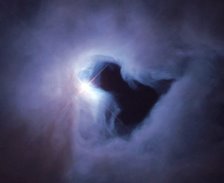

































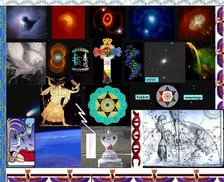
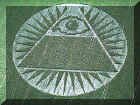




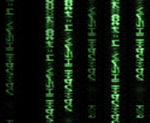



































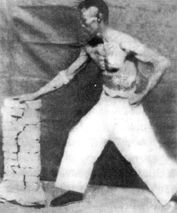






















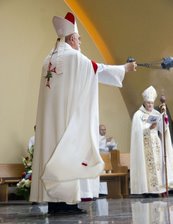
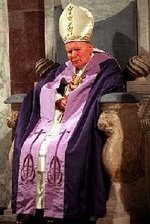








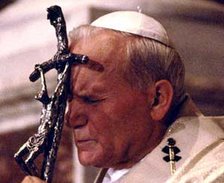



































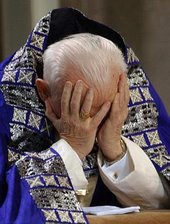







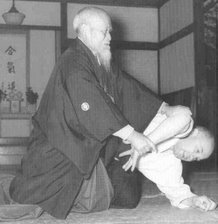

















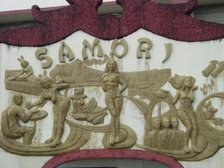





















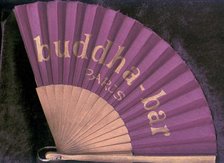
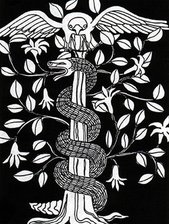








No comments:
Post a Comment